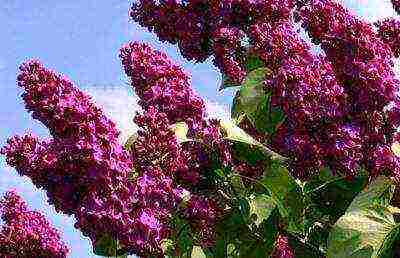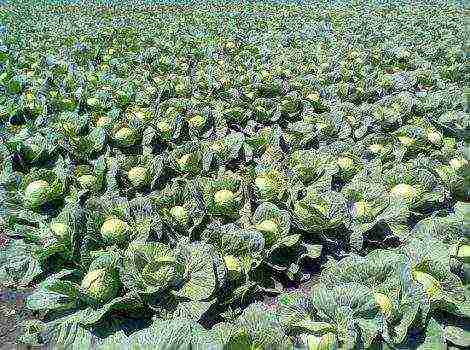Content [show]
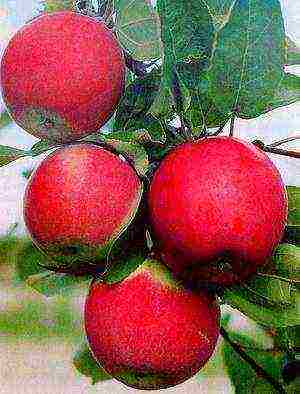 For a long time I did not dare to deal with this topic. It is the apple trees for Ukraine. Not because I have no idea about this region. Was born here. And I live. I see many varieties. I hear different opinions about them.
For a long time I did not dare to deal with this topic. It is the apple trees for Ukraine. Not because I have no idea about this region. Was born here. And I live. I see many varieties. I hear different opinions about them.
And I grow. How successful? Most likely not very much. Give me back 10-15 years. Maybe I would have done it more successfully. Knowledge is power. There was even a popular science magazine with that name.
The market offers a lot of apples. In a month, the early apples will appear. And in the market they lure Mutzu with their appearance. Champion. Ligol.
At one time, I really wanted to buy a Golden Delicious seedling for planting. There was an opinion among gardeners that such apples could not be grown here. To be fragrant and sweet. And large ones. And I believed them. But I bought it and planted it.
For yourself, not for the market. Now it is growing. There are problems. Apples are smaller. But this is Golden! So let's try to figure it out together. What should be planted and grown in Ukraine from apples.
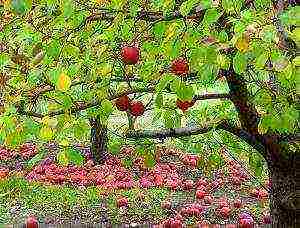
We take so to speak on a global scale:
- About 70 million tons per year. Most in China. There are more people living there. They need a lot of apples;
- Europe is more interesting for us. In Poland - almost 3 million tons. Have noticed. More than in Italy and France - more than 2 million tons each. And Germany - just over 1 million tons;
- What are they used for. The advantage is given to fresh consumption. The best varieties;
- Unbeatable are used for processing. Numerous and varied products.
Apple trees expand territories... Where they are not only grown! Thailand and Brazil have also joined the apple territories.
But industrial cultivation of apples is preferred in countries with a temperate climate. Take Poland. They grow more than the need of their population. Almost three times. The rest is sold. All over Europe. And in Ukraine. About 90% of apples imported to Ukraine are from Poland.
What gives profit and return on costs:
- Fertile soil;
- Regular watering and feeding;
- Lack of late frosts;
- Selection of good productive varieties. Demanded in the market;
- Availability of modern refrigeration equipment. For long-term storage;
- Growing staff. Close to gardens. And the organization of work;
- Agreements for the sale of the grown crop.
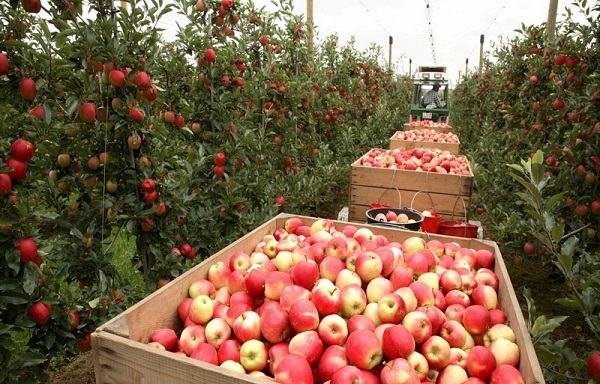
Industrial apple orchard.
What is Ukraine for growing apples. The potential is enormous:
- 41 varieties were bred by Ukrainian breeders;
- An excellent scientific base with long-term traditions and developments:
- Institute of Horticulture UAAS. With its branches;
- Mliev Institute of Horticulture named after L.P. Simirenko;
- Institute of Irrigated Horticulture named after M.F.Sidorenko UAAS.
- Unique and varied weather conditions;
- Fertile soil on a vast territory. It's just that the black soil is not taken out in trains.
All this potential must be realized. After all, and there is plenty to choose from. Therefore, we look further at the photo with the name and description of the varieties.
general characteristics
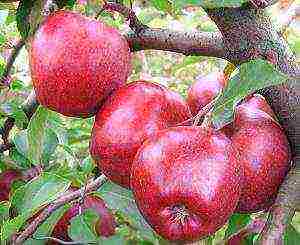 I know for sure that it is difficult to give a general description. A lot of varieties are grown. And different requests. What can we say about farmers and industrialists. If there is no single view among amateur gardeners.
I know for sure that it is difficult to give a general description. A lot of varieties are grown. And different requests. What can we say about farmers and industrialists. If there is no single view among amateur gardeners.
One is happy with 3-5 apple trees. The other does not calm down on dozens of varieties. Breeders are constantly on the lookout. Maybe that's just good.
It's like a beautiful woman. Admired by many. Who out loud. Who is about himself. And not everyone dares to do something. There are others around. Beautiful. Attractive. And ... real.
So with apples. I want to. Delicious. Beautiful. Solid size. Every year. And more. Care is easier. So that they do not get sick and be healthy.
But the trends are noticeable. The market is increasingly dictating conditions. What to grow and what kind.
Many people want to surprise others:
- Color;
- Size;
- Taste;
- The shape of the crown, especially its decorativeness;
- Productivity;
- Terms of preservation.
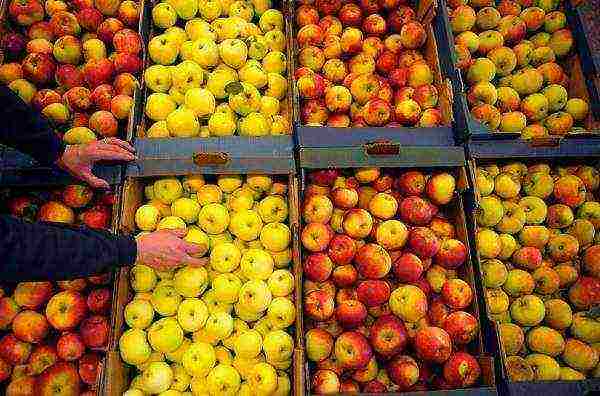
Variety of apple varieties.
More attention is paid to foreigners. Look at the prices of nurseries:
- Golden Delicious;
- Red Delicious;
- Jonagold and Jonagored;
- Gala and Gala Mast;
- Mutsu;
- Fuji;
- Honey Crisp;
- Pink lady;
- Pinov.
And the prices are reasonable and affordable. Local developments are not very attractive. They are still looking for and asking:
Local developments are not very attractive. They are still looking for and asking:
- White filling;
- Glory to the winners;
- Renet Simirenko;
- Calvil is snowy.
Carefully! Sellers advise against. They offer super new items. But they ask. And they buy. Very often, neither one nor the other.
But I will note. There are also positive aspects. AND very promising new Ukrainian varieties. The names say little else:
- Scythian gold;
- Eder;
- Amulet;
- Gypsy (not German Gypsy).
New variety of apple-tree of Ukrainian selection Violet
- The popularity of the variety is growing rapidly;
- First of all, because of the original appearance. It was not by chance that they called it Violet. The purple color of the fruit will attract the attention of even the indifferent;
- So many are planted as an ornamental tree. The compact rounded shape is also taken into account.
- Slightly flattened;
- With lots of apples. Very productive variety... Even surprisingly fruitful. Someone even sees bunches of apples. Hanging down;
- And they eat it with pleasure. Apples weighing from 110 to 150 grams will surprise you with their dessert taste.
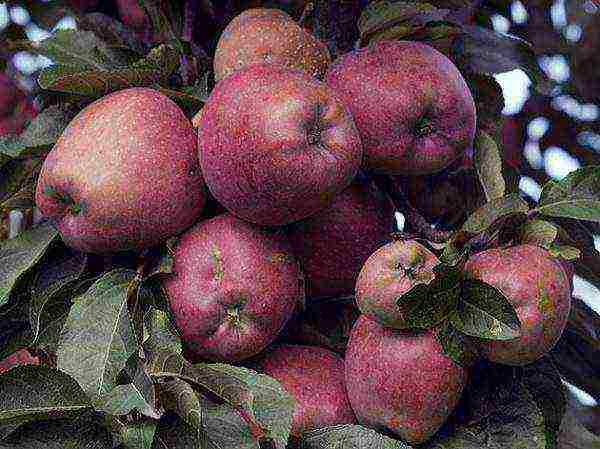
Violet.
And be careful! Regulate your harvest. So that the branches do not break off. And keep the beautiful shape.
Good varieties of apple trees for Ukraine
Like a preface. Many varieties are familiar to buyers. Even more so for gardeners. And for many, these are new items.
Askold
- Created by Ukrainian breeders. V.P. Kopan;
- The original shape is an inverted pyramid. Or cupped.
Consider:
- For the correct formation of the crown, it is advised to involve a gardener.... Maybe he will do the rest? And we only eat apples;
- Good resistance to scab. Powdery mildew is a serious concern;
- Rounded slightly flattened fruits up to 200 grams;
- Ripen in mid-October. Stored until May;
- The first apples are 2-3 years after planting and are stored until summer;
- Regulate productivity.
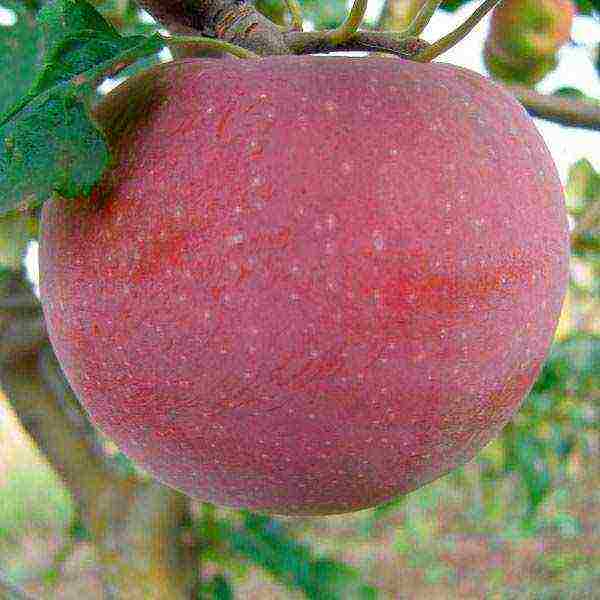
Askold.
You can find more information about Askold's apple tree here.
Arriva
- Winter grade;
- Authors Swiss breeders;
- Medium-sized tree;
- Bears fruit annually;
- Its highlight is its high resistance to diseases with scab (immunity) and powdery mildew;
- An apple can retain its qualities, and they are excellent, even under normal cellar conditions. Almost until spring;
- Rounded, but there are also slightly elongated, fruits weighing from 150 to 180 grams. With orange blush. You can store it in the cellar until March.

Arriva.
Gloucester
- German origin and roots;
- Strong branches form a pyramidal crown... Solid;
- The creators gave this variety a high resistance to diseases of apple trees. Especially for scab and powdery mildew;
- Remove ripe apples in early October. Considering the weather surprises. To remove not frozen. And store until April. And there yourself look out for the suitable weather;
- The apples are worth it. Elongated. Or cone-shaped, burgundy and weighing even up to 200 grams. With prominent ribs;
- Evaluated by tasters at 4.5 points.
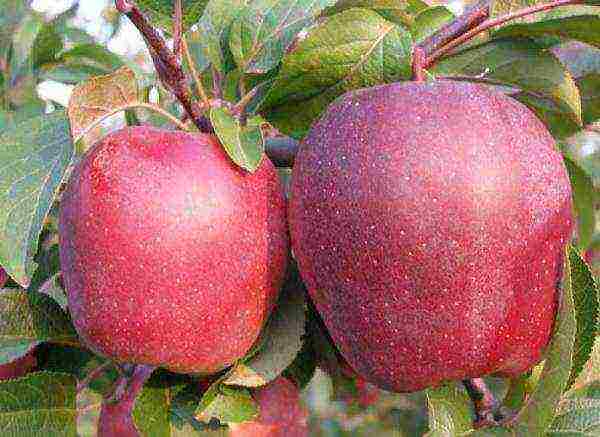
Gloucester.
Learn more about the Gloucester apple variety in this article.
Teremok
- Autumn variety;
- High winter hardiness and ability to resist disease increase the interest of gardeners in it;
- They always want something new. And if a friend said that he has an interesting variety. And he treated me to. The dream is gone! Until he is in his garden;
- And here also, in addition to all of the above, excellent taste and marketability;
- The original color is orange-scarlet. Weight from 150 to 210 grams. And tasters give only 4.2-4.5 points.
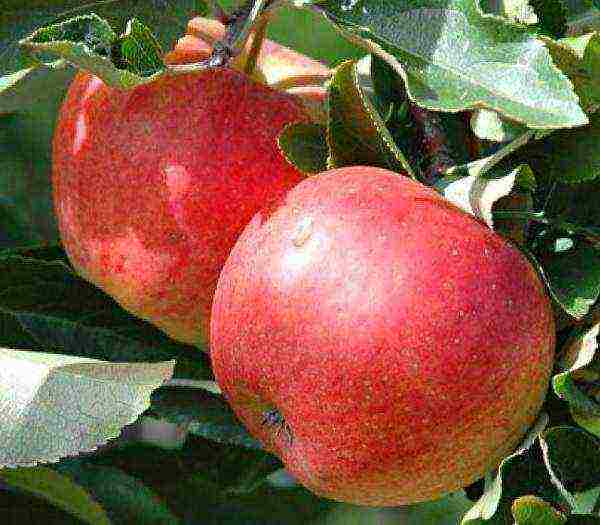
Teremok.
You can read more about the Teremok apple variety here.
Scythian gold
- Winter grade... Even early winter;
- And early harvests from the time of planting (3-4 years);
- Annual harvest. Pretty good;
- It is adapted to the winter conditions of Ukraine. Endures them steadily. Freeze-free;
- Mark. Immune to scab. That makes it possible to eat apples without being damaged by diseases. Especially scab;
- Large fruit with an orange blush (sunny side) on a yellow surface.
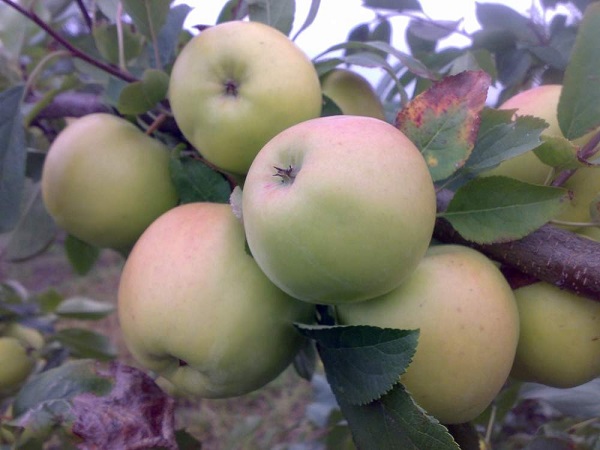
Scythian gold.
Ornament
- Late winter variety;
- Already in the State Register;
- For intensive cultivation. You will see apples quickly - 2-3 years after planting. Yields from 4-5 years of age are already solid and constant;
- Resistance to diseases and frost is sufficient for farmers to find a place for them in their gardens. In Polesie and the forest-steppe of Ukraine;
- Carmine red coloring and dessert sweet and sour taste further increase interest in them.
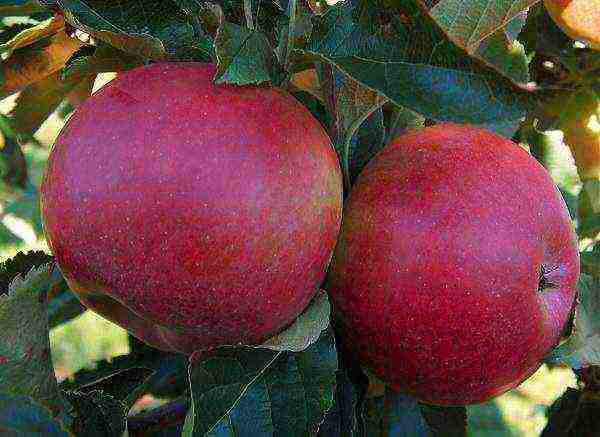
Ornament.
Idared
- I read it. That he is promising. I will put it differently. Feels great in our gardens;
- In my garden for 20 years. The variety is among the favorites in the family. Excellent yield. Apples are lovely. An amazing combination of sweetness and acidity;
- I compared the name with Mount Ai-Petri in the Crimea. For myself and others, I call it "Oh, yes, red." In my usual cellar it can be up to March-April from October. Depends on the harvest. We eat with pleasure;
- Experts say that until August it retains its taste.
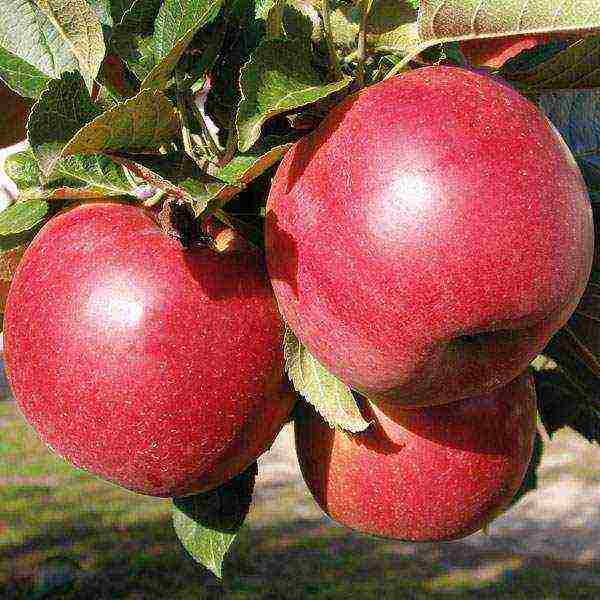
Idared.
You will learn more about the apple variety Idared in this article.
Jonagold decosta
- I recommend. How one of the best clones of Jonagold;
- And this despite the fact that this variety is not an example in resistance against diseases: against scab - medium. And against powdery mildew he is rather weak;
- Sami apples up to 200 grams, their very attractive appearance and taste incline him to plant and grow in his garden;
- And you will not make a mistake in doing so;
- An acquaintance of mine preferred Jonagored (Highlander). And he considers him the best.
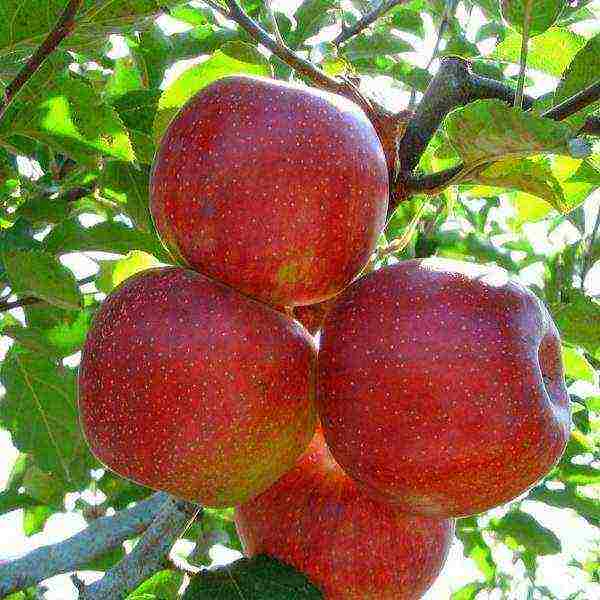
Jonagold decosta.
You can read more about the Jonagold Dekosta apple variety here.
Mutsu
- Last fall I planted Beni Shogun and Delbarestival seedlings in my garden. But I will definitely find a place for Mutsu;
- The amazing result of crossing Golden Delicious and Indo-Japanese varieties;
- Winter variety;
- October 10-20 is suitable for picking light yellow fruits;
- The size and weight are very decent - up to 300 grams;
- And you can store it for almost 9 months. This is already the second half of June;
- So I want to grow at myself. After all, they recommend it for delicate connoisseurs of apples.
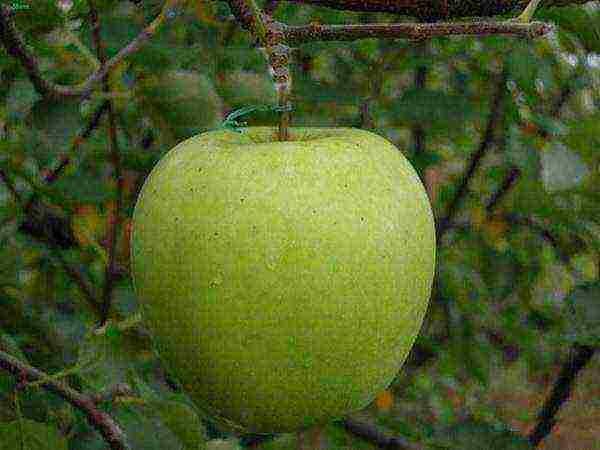
Mutsu.
You can find more information about the Mutsu apple tree here.
Florina
- Winter variety;
- The fruit has a noticeable bluish bloom on the red blush. And white spots;
- Apples are not surprising 120-150 grams in size. Tasters' marks do not exceed 4.3 points. Even those in the sun. AND have an amazing aroma.
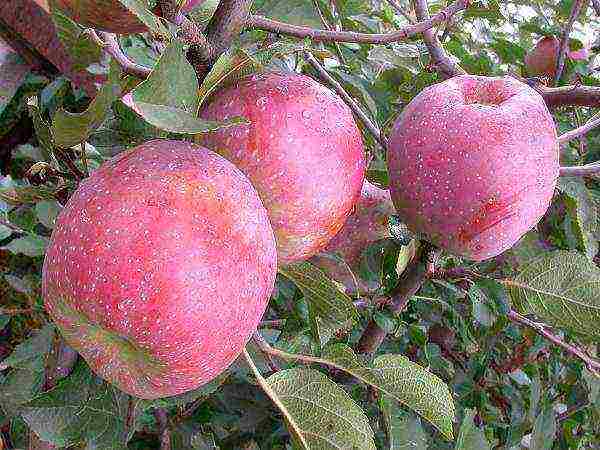
Florina.
Read more about the Florin variety in this article.
Williams Pride
- Americans withdrew very early summer variety;
- Vigorous with fruits not ringlets and spurs. And annual increments.
- Him scab immunity;
- It also surprises with its color. Dark cherry. Even the pulp with such a shade;
- And remember the taste. Wine sweet;
- Already at the end of June, in some regions they begin to enjoy it. There are no other apples yet;
Advice! It is worth growing at home!
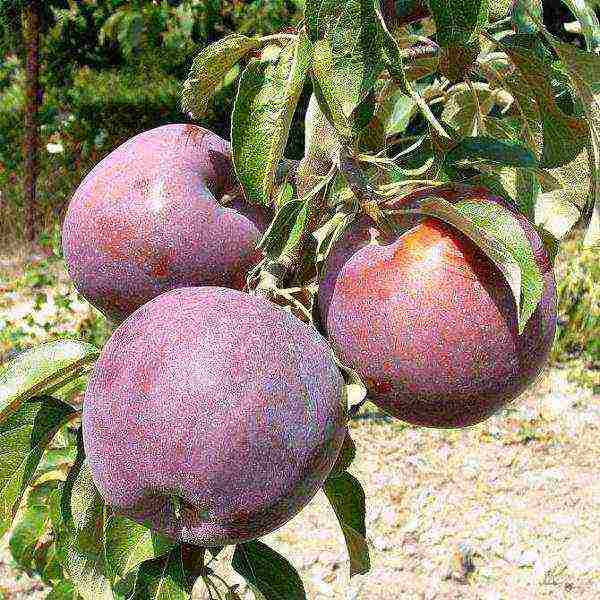
Williams Pride.
You will learn more about the Williams Pride apple variety in this article.
Eliza
- Club variety from Holland;
- Medium-sized crown;
- Deep red blush all over;
- With a brownish tint;
- Sweet and sour and juicy white pulp. A little green;
- In late September and early October, they are removed from the trees for storage. And you will eat until spring;
- They tolerate transportation well;
- We haven't studied it enough yet.
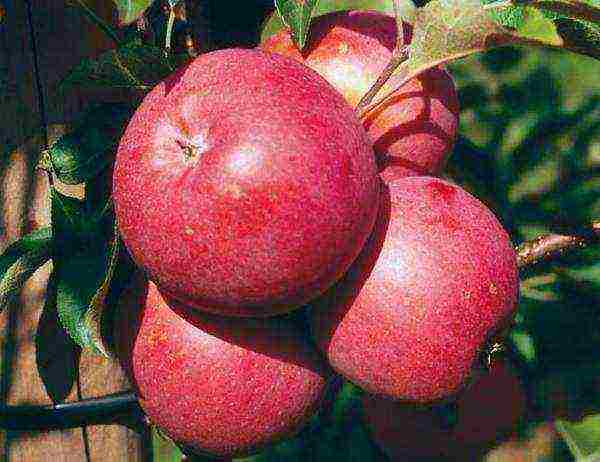
Eliza.
You can read more about the Eliza apple variety here.
Honey Crisp
- The Americans brought this winter grade;
- Crohn unheated both on dwarf and semi-dwarf rootstocks;
- Winter hardiness for Ukraine is sufficient. So that the yield is good;
- Large apples;
- Some even up to 260 grams. Sweet and sour taste remembered. AND light aroma;
- And also a red blush. Slightly marble;
- Ripen by the end of September. For removal from trees and storage. They can lie until February.
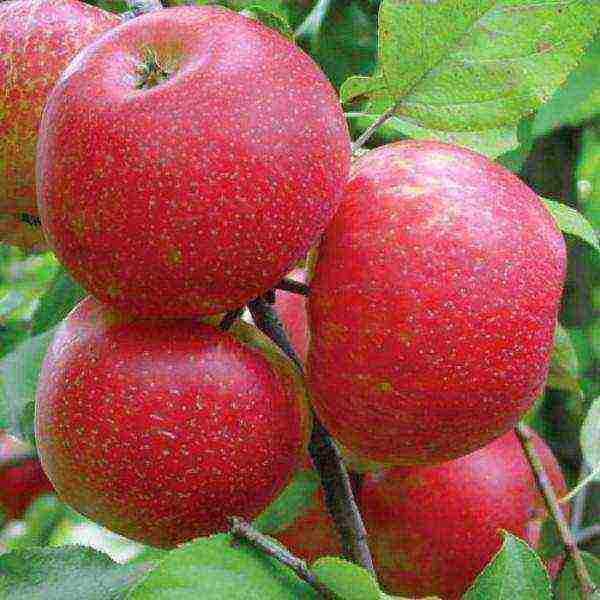
Honey Crisp.
You can find more information about the Honey Crisp apple tree here.
Renet Kuban
- Clone Renet Simirenko... They compare it with him;
- Since 1998 in the State Register of Russia;
- Weak tree with hanging branches;
- Fruits are greenish in color. There may be a raspberry blush under the sun;
- The fruits are not uniform. Very tasty. Dessert;
- But they persist even until summer;
- Diseases are able to resist with your help;
- It endures both frost and heat.
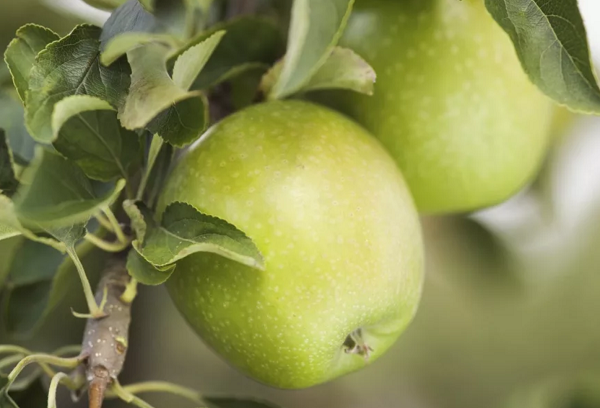
Renet Kubansky.
Pink lady
- Winter grade from New Zealand;
- Since 1975 he has been developing the European market. And Ukraine, including;
- Crossed by Golden Delicious and Lady Williams;
- Very much in demand among gardeners. Also called two-color. Because of the bright red blush;
- Highly rated by tasters - 4.9 points. And there is a reason. Apples average 170-200 grams. Dessert;
- Can be stored for almost 10 months after being harvested in October.
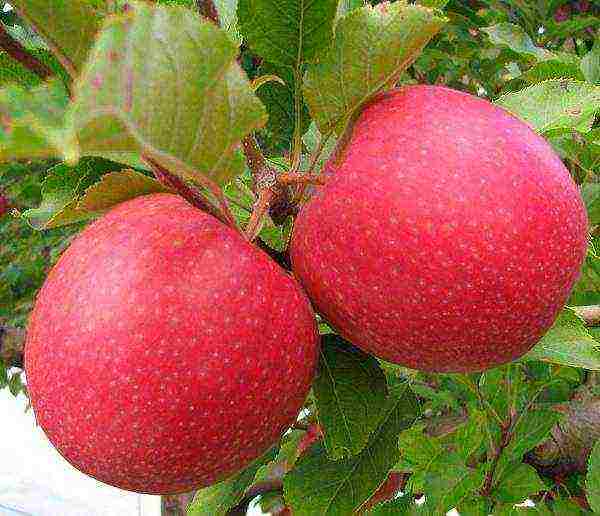
Pink lady.
Liberty
- American selection;
- Medium and weight sweet and sour fruits with a maroon color over the entire surface;
- They must be removed in mid-September. And processed into juices, compotes. Jams. Pies;
- Stored for only a couple of months. But in the refrigerator it can take up to 5 months.
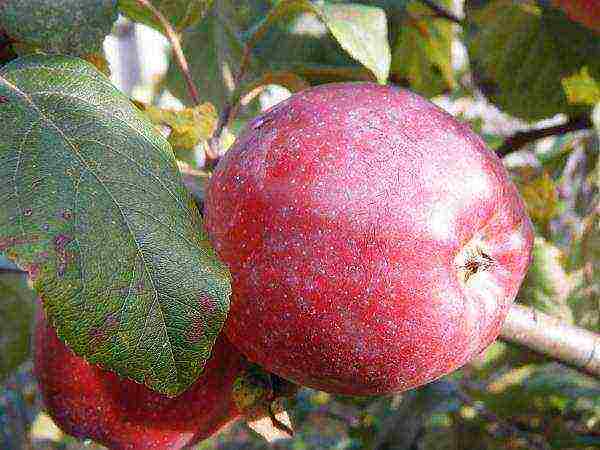
Liberty.
You can read more about the Liberty apple variety here.
Syabrina
- Winter grade from Belarus;
- Medium height tree;
He is appreciated by:
- Per high yield... Annually;
- Disease resistance apple trees. Especially for scab.
- Already in the third year after planting, it can present you with apples. If there is a seedling on a clonal rootstock;
- Fruits are yellowish with a raspberry blush. Taste - 4.5 points;
- Store in October. Eat until February.
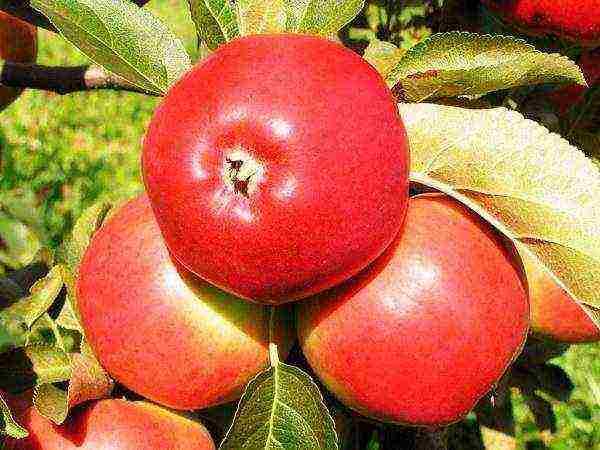
Syabrina.
Belarusian sweet
- The name suggests the origin winter variety. Polesie gardeners are already growing it;
- Deserves his attention scab immunity (Vf gene). And not only;
- High winter hardiness same;
- Very soon it begins to bear fruit. Already in the third year after landing. Often the second;
- Medium height tree... The crown is round;
- Apples up to 180 grams;
- The green color of the fruit is covered with a reddish blush over the entire surface;
- In January-February, they eat it.
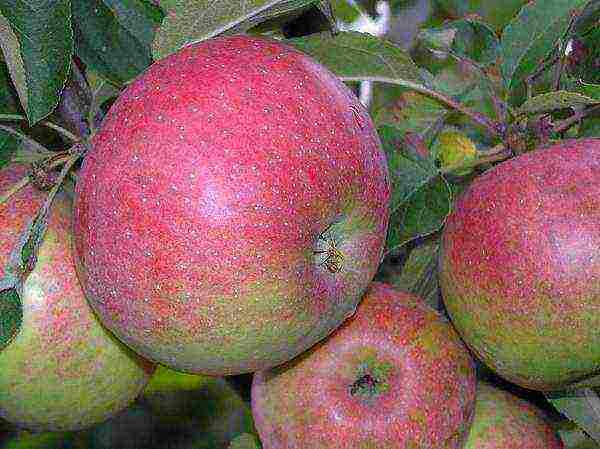
Belarusian sweet.
Read more about the Belarusian sweet variety in this article.
Gypsy
- The variety comes from Germany;
- He has been known for a long time. More than three centuries;
- The fruits are round and slightly flattened. Medium size. The slightly yellow skin is covered with a crimson blush. And light specks. Even the flesh is light pink in color. Sweet and sour and juicy;
- It is not in great demand among gardeners. Is it like a curiosity.
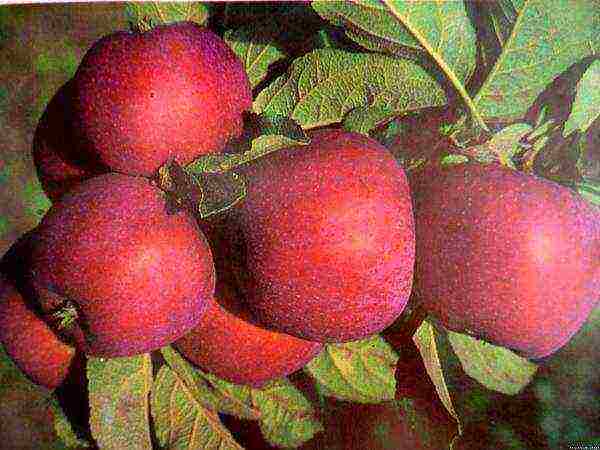
Gypsy.
Renet Mlievsky
- Clone of the Renet Simirenko variety;
- Winter grade;
- Exceptional winter hardiness and disease resistance;
- Quite tall trees. Can be up to 5 meters;
- Bright green slightly elongated fruits reach a weight of 200 grams;
- Sweet and sour taste... Even like wine;
- They are filmed in October. To store right up to the May holidays. If not using.
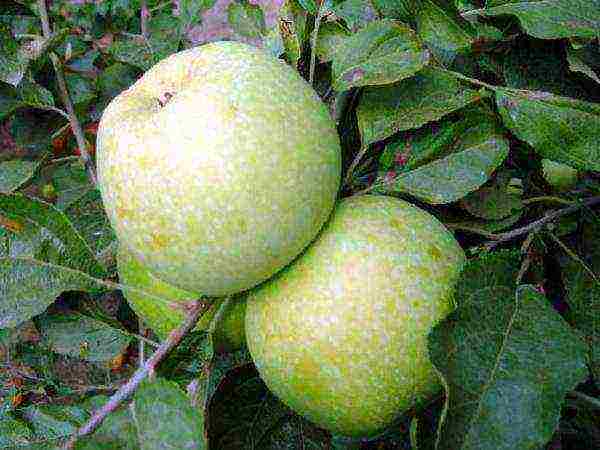
Renet Mlievsky.
Other
 Don't forget about famous varieties of apple trees. Delicious and reliable. Albeit with its bells and whistles and diseases:
Don't forget about famous varieties of apple trees. Delicious and reliable. Albeit with its bells and whistles and diseases:
- White filling;
- Antonovka;
- Glory to the winners;
- Borovinka;
- Bellefleur-Chinese;
- Calvil is snowy;
- Renet Simirenko.
And also world celebrities:
- Melba;
- Mekintosh;
- Golden Delicious;
- Red Chief;
- Gala;
- Jonathan;
- Pinova;
- Champion.
And others. You can't include everything on the list. I would like to surprise the newcomers.
Varieties rating
 Who composes them? These ratings? Are there numbers? How much of each cultivar is grown? How is it implemented? How is it acquired in nurseries? Can you grow it? And others characteristics:
Who composes them? These ratings? Are there numbers? How much of each cultivar is grown? How is it implemented? How is it acquired in nurseries? Can you grow it? And others characteristics:
- Taste;
- Colour;
- The size. It is fruit;
- Ripening period;
- How quickly they begin to bear fruit;
- How resistant they are to frost, disease, transportation;
- How to buy.
Notice! Europe, by the way, is calculating it.
Option:
- Folding;
- Glory to the winners;
- Calvil is snowy;
- Golden Delicious;
- Red Delicious.
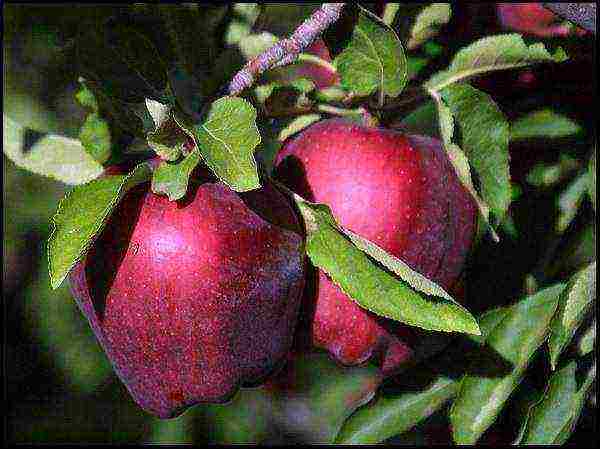
Red Delicious.
You may have a different opinion about the best varieties.
By zoning
Very often in the characteristics you will find as a weighty argument for the acquisition that the variety is zoned in your region. You can listen carefully. It's like a local variety. Many have it. And you take something else for yourself. But this is my opinion.
By the characteristics of fruiting
For an intensive garden
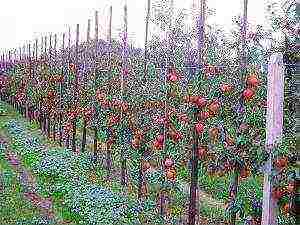 An intensive garden involves dense planting of apple trees. Which make it possible to use various techniques for caring for him. And they are possible when using low-growing trees.
An intensive garden involves dense planting of apple trees. Which make it possible to use various techniques for caring for him. And they are possible when using low-growing trees.
Just and select varieties on dwarf and semi-dwarf rootstocks:
- Pinova;
- Starkrimson;
- Eliza;
- Gala;
- Gloucester;
- And many others.
Large-fruited
Large gardeners consider apples weighing more than 200 grams... And for some gardeners, as in the joke about the fisherman, tying their hands will not help either.
BUT the largest known apples:
- Aport and Bellefleur-Chinese - up to 700 grams;
- Antonovka - up to 600 grams;
- Mutsu - up to 300 grams;
- Fuji - over 250 grams;
- Ligol - about 600 grams;
- Jumbo Pomme (apple-elephant) - almost 1 kg.
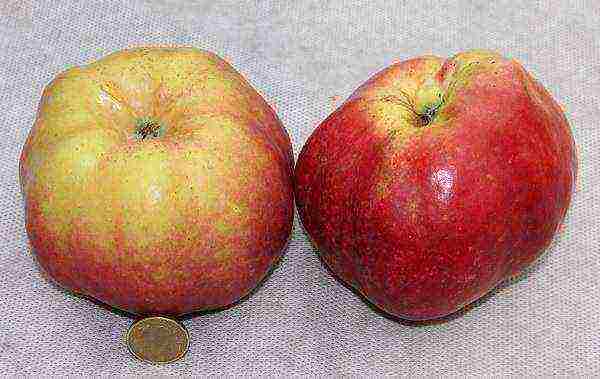
Apple Jumbo Pomme.
Important! In the west, they are not in great demand. The reason is commonplace for us - they cannot eat in one sitting. Experts are more inclined towards one-dimensional - 150-220 grams.
By the timing of fruiting
Early
In summer, you watch the ripening of apples with special interest. And the first to ripen are summer varieties. They are also called early varieties of apple trees.
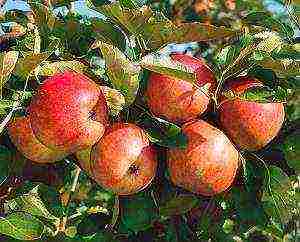 Summer varieties of apple trees:
Summer varieties of apple trees:
- Ripen in the territory of Ukraine in different ways. But this from the beginning of August to the middle. And we begin to gnaw them back in July. Their removable maturity matches that of the consumer;
- The sugar content is high. Juicy pulp;
- Short shelf life. Only 2-3 weeks are at your disposal. To deal with them:
- Eat as much as possible fresh;
- Prepare juices, jams;
- Bake pies with apples;
- Cut to dry;
Here are just a few:
- White filling;
- Melba;
- Early sweet;
- Vista Bella;
- Williams Pride;
- Katia;
- Earley geneva.
Winter
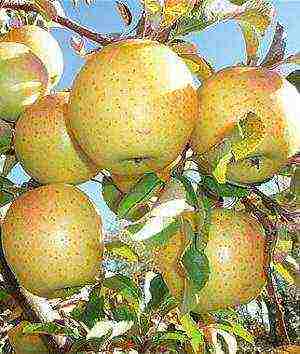
- Breburn;
- Pink lady;
- Ozark Gold;
- Ruby;
- Elista;
- Rubinette;
- Delbar Jubile;
- Fuji;
- Honey Crisp.
Some of them cannot be pronounced. Not something to remember. They still acquire a lot Golden Delicious, Snow Calvil, Renet Simirenko, Idared, Jonathan. Spartan.
The best autumn
Autumn. Or late summer. You will not be able to store for so long. 2-3 months. And no more. So you need to have time to eat and process. Including soak. In a good way. In a barrel:
- Jenister;
- Gala Mast;
- Delicacy;
- Zhovtneve duki;
- Kidds Orange Ed.
Gardeners are still interested in Mekintosh, Welsey, Bellefleur-Chinese, Antonovka and its subspecies.
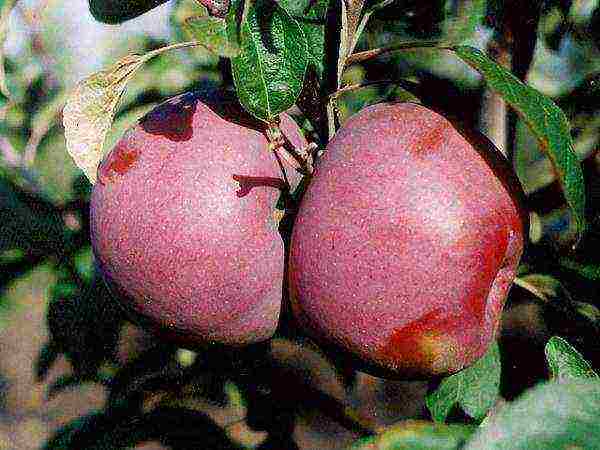
Mekintosh.
By winter hardiness
Itself the concept of winter hardiness includes:
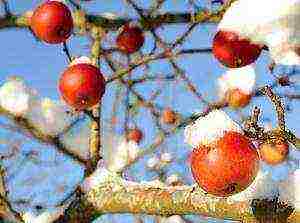
- Ability to tolerate low temperatures. And for a long time. And extreme. Lowest;
- Resistant to severe frost in the first weeks of winter;
- How the variety withstands temperature extremes. Especially when frost returns after thaws;
- How to recover from frost damage:
- Weak winter hardiness at the Champion, Idared, Gala;
- Winter hardy local varieties White filling. Glory to the winners, Renet Simirenko, Snowy Kalvil.
You can try to grow varieties of Russian breeders. 36-40 degrees of frost for certain varieties are not terrible. And they taste good.
Suitable for long-term storage of fruits
They are are well known:
- Jonathan;
- Golden Delicious;
- Calvil is snowy;
- Renet Simirenko.
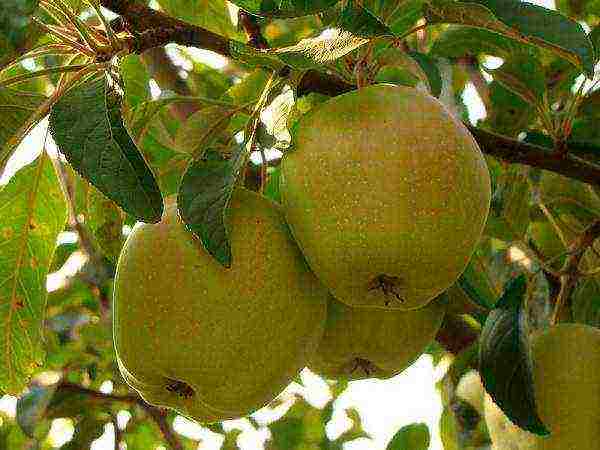
Calvil is snowy.
And you choose yourself from the ones listed earlier. Now 6-7 months of storage does not surprise anyone. And also modern technologies.
Advice! You can also search for storage periods up to 2 years. And there are such!
Disease resistance
- In the descriptions of the varieties, you hear the word "resistance" very much;
- So sustainability presupposes. There are more than enough reasons for disease. And they will make repeated attempts to hit the next object. Here's how he will react. And this one resilience is precisely the ability to resist disease. And overcome her;
- And with your help. If you plant an apple tree and do not carry out preventive treatments (3-4 per season), then you will have to eliminate the consequences with a large volume of treatments. And not right away. Spend time too. And there will be problems with the harvest.
To scab
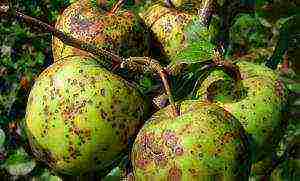 As in life:
As in life:
- Someone was born healthy. And this is a good start for life. If you multiply it. And not to ruin;
- And someone was born frail ... Then continue yourself ...
And I'm talking about an apple tree. Scientists have asked and bred apple varieties that are immune to scab. After all, she gets good grades more than others. Immune varieties of scab do not care:
- Foreign:
- From the Czech Republic - Topaz, Rubinolla;
- From Germany - Relinda Remo, Revena, Rosana;
- American Enterprises and Freedom;
- Polish - Sava, Vitos, Gold Rush.
- Belarusian:
- Syabrina,
- Imant,
- Darunak.
- Russian:
- Apple saved
- Anniversary,
- Imrus.
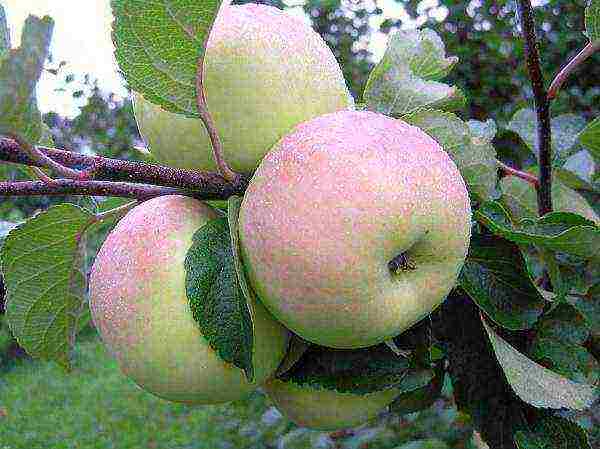
Imrus.
Ukrainian breeders have brought and offer immune varieties:
- Late Autumn Amulet;
- Winter:
- Scythian gold;
- Eder;
- Gypsy girl;
- Guarantee;
- Perlyna of Kiev.
They are in the State Register. Delicious. Winter hardy. They are already successfully competing with foreign ones. Many of them are practically unknown. It is today.
Examples of varieties for Ukraine
Columnar
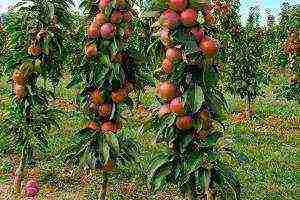 It has been closely studied in Ukraine since the 1980s. Russian breeders have developed many varieties. Suitable for growing on the territory of Ukraine. But varieties deserve attention more:
It has been closely studied in Ukraine since the 1980s. Russian breeders have developed many varieties. Suitable for growing on the territory of Ukraine. But varieties deserve attention more:
- Arbat;
- Barguzin;
- Currency;
- Ostankino;
- Vasyugan.
Recommendation! They are used more as beautiful forms for decorating the garden and territory. They haven't quite surprised them with apples yet. Like forms.
Dwarf
For a long time in the market when purchasing seedlings, one of the first questions of the buyer "On a dwarf rootstock?».
You can purchase the apple variety on different types of rootstocks.Most Westerners are grafted onto clonal rootstocks. And the difference between dwarf and semi-dwarf is not so significant. Only a mature tree can already see this.
But know and consider not only the advantages and advantages of low-growing apple trees:
- After all, they require systemic care;
- Especially watering and feeding;
- And protection during the winter.
The most common M-9, M-7 are dwarf. M-106, M-26. The seedlings are spread on them.
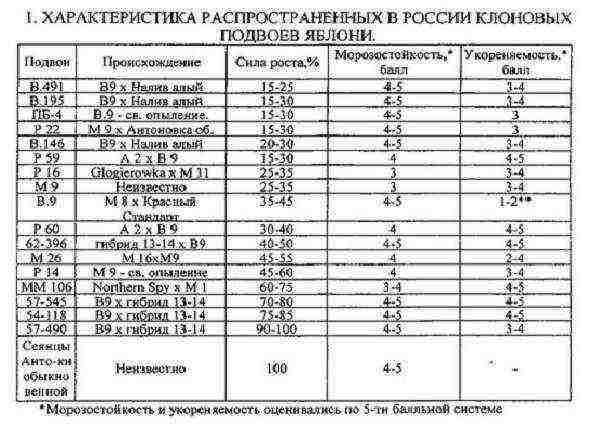
Characteristics of apple rootstocks.
Trellis
Trellis crown formations are increasingly of interest to garden designers. And more site designers around the house. It is not the varieties that are important here, but the shapes of the apple trees.
Useful videos
Watch a video of what the Violet apple tree looks like:
Watch the video on how to shape an apple tree for an intensive garden:
Watch a video about columnar apple trees:
Watch a video on how to protect an apple tree from diseases and pests:
Conclusion
- As you can see, there are conditions. There is something to choose;
- But not everything is so simple. And we cannot expect to be welcomed with open arms in the global apple market. Places under the sun must be conquered;
- So far we have lost the Russian market;
- And the number of apples grown is growing!
Nature generously endowed Ukraine with its gifts: almost half of the land falls on fertile black soil, and the climate is favorable for garden and vegetable garden crops. Of course, the most popular fruit crop in Ukrainian orchards is the apple tree. The variety of varieties of her seedlings offered for sale can confuse a novice gardener. Especially if the area for planting is small, and you want to choose the highest quality and most valuable. What to do? Do not take at random, do not rush, but carefully weigh the pros and cons of each variety and plan the future of your garden for many years to come. This article will help you understand the variety of varieties and choose the most suitable one.
Popular in Ukraine varieties of old selection
Old varieties were sometimes bred by accident. The breeder walked through the garden of Platonov's farm in the vicinity of the town of Mliev, Cherkasy region, noticed an interesting apple tree - and Renet Simirenko appeared, who has been firmly among the best varieties for almost a century and a half and is not going to give up positions yet.
The famous Antonovka is also widespread. This miracle apple tree of folk selection is grown even on the African continent. It is believed that it appeared as a result of crossing a wild and cultivated apple tree of an unknown variety. Such a humble background - and such a glorious, amazing fate. This is no longer just a variety, but a variety that gave rise to five dozen new varieties.
So, the two most popular old varieties have already been named. For the third place, Papirovka, aka White filling, and Glory to the Peremozhtsy (Glory to the Winners) can compete. Both are good, both are famous and loved by the people.
The Glory to the Winners variety was obtained by crossing Papirovka and Macintosh back in 1928 at the L.P.Simirenko Mlievskaya station. And, most interestingly, the Macintosh variety was also bred from an apple tree that John McIntosh found accidentally on his estate.
Such is it, the old selection, all built on chance finds and sudden discoveries. But we remember and value its results to this day.
Characteristics of popular old varieties
We remember and love the taste of these apples from childhood.
Renet Simirenko
Green Renet Simirenko got its name for the intense green color of the fruit with numerous white dots. This late autumn and early winter variety is known and loved for its excellent taste, which tasters call "harmonious wine-sweet", and dietary properties.
Renet Simirenko apples are low in acid and sugars, so they can be used as a snack without risk to the stomach.
The flesh of the fruit of a characteristic greenish color, very juicy and aromatic, the mass is from 150 to 200 g. The apple has a short and thick stalk, it is very strong on the branch.There is a waxy coating on the dry and dense skin of the fruit; during storage, the surface turns slightly yellow and may be covered with a faint tan of a red-orange hue. The advantages of the variety also include high keeping quality (fruits are stored until June), versatility of use, high yield and drought resistance, the ability to recover from damage. Among the shortcomings, it should be noted the average winter hardiness, low early maturity, the risk of damage by scab and powdery mildew. Medium-sized tree (5–6 m tall), with a round, dense crown. Pollinators are required, such as Golden Delicious.
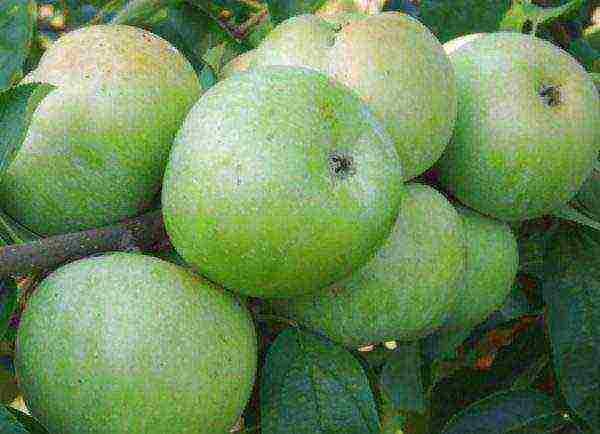
Renet Simirenko is a classic that does not age over the years
Antonovka
They say that Antonovka has a unique taste and aroma - and this is true. But lovers of strongly expressed sourness will like it. But Antonovka contains a lot of ascorbic acid (14%), which is an undoubted advantage, especially in late autumn and early winter, when there is a lack of fresh vegetables and fruits. The variety ripens in early autumn, is stored for up to three months, in addition, it is widely used in cooking. Fruits are often uneven in shape, but large - up to 300 g. The pulp is juicy, slightly grainy, loose, perfect for making jams and marmalades.
A characteristic feature of the variety are numerous and large subcutaneous dots of white color and a strongly corroded funnel, sometimes with a transition to the fruit. During storage, apples that are greenish at first turn yellow, an orange or pink blush may appear.
The advantages include high frost resistance and frost resistance, generous harvests (but they are irregular). Negative qualities of the variety: low early maturity, susceptibility to damage by scab and moth (very strong in some years). The tree is tall, grows up to seven meters, spreading, the crown grows quickly and requires frequent thinning, which can also be attributed to disadvantages.
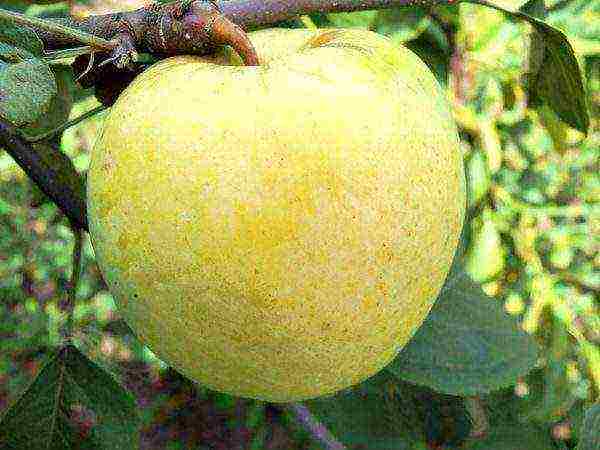
Old Ukrainian gardens cannot be imagined without Antonovka
Papirovka (White filling)
Papirovka, or White filling, is a variety of rare beauty. When ripe, the apple pours white and becomes almost transparent. Papirovka comes from the Baltic States, but has long taken root in Ukraine and feels great. Alabaster, Pouring white Baltic - that's how it is also called. And the name "Papirovka" comes from the Ukrainian word "papyr", that is, "paper". The light green skin of the fruit is covered with a thick white coating, giving it a paper-like appearance. And the pulp of this variety is white, tender, friable, with a refreshing pleasant taste, but again sour (and the content of vitamin C is more than 20%).
Unlike Antonovka, the fruit has a weak aroma, but there is a valuable advantage - early ripeness, so you can enjoy White filling in the middle part of Ukraine from the beginning of August, and even earlier in the south.
The apples are medium-sized, up to 150 g, a feature of the variety is a longitudinal narrow seam. If you are an adherent of the old classics in the garden, you can choose the same Antonovka as a pollinator for Papirovka.
Papirovka has many pluses, but each has a minus. Ripens early - but crumbles quickly. Gives excellent yields - but not from year to year. Fruits are poorly stored, do not tolerate transportation. If you do not cut it, it will grow and thicken quickly. Winter hardiness is high - but resistance to scab and powdery mildew is below average, especially in rainy summers. However, an indisputable and significant plus: the jam and compote from these apples are excellent!
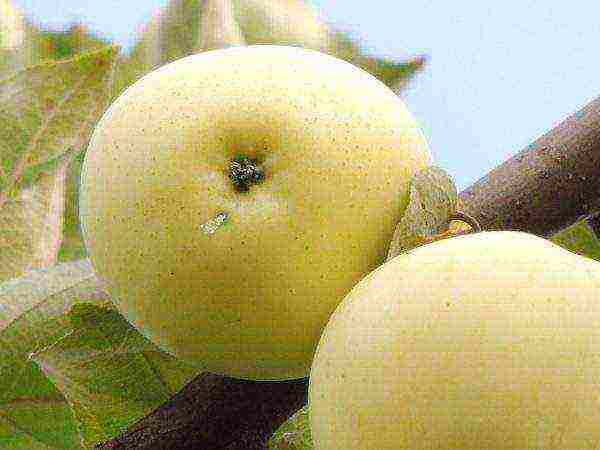
Not everyone knows what Papirovka is, but White filling is known to everyone
Glory to the Peremozhtsy
The variety Slava Peremozhtsy (Glory to the Winners) is also widespread. An early variety, the first collection in the south of Ukraine in late July and early August. The fruits are not small, up to 180 g, beautifully shaped, with a thin yellowish skin, on which a bright blush in the form of red stripes looks very elegant. There are many light dots with corked centers under the skin.The pulp is white with a light creamy and even pink tint, juicy, has a pleasant aroma, but the taste is more sour than sweet and sour.
The yield of the variety is high, but there is a periodicity over the years. Ripe fruits must be picked in a timely manner, as they tend to crumble, especially in dry summers. Slava Peremozhtsy tolerates cold winters well, but has relative immunity to scab. The disadvantages include tallness and a tendency to form a thickened crown.
The variety is self-fertile, so pollinating varieties, for example, Melba, need to be planted nearby.
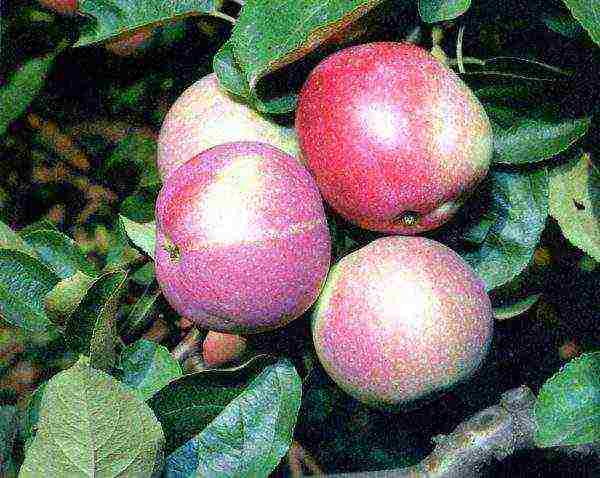
The Slava Peremozhtsy variety at one time became a real victory for breeders
Disadvantages of varieties of old selection
Based on the example of the best varieties considered, we can judge that the old selection suffers from typical shortcomings:
- sour taste of the fruit. Now that there is a rich variety of refreshments, ice cream and pastries on the market, the sour apple is no longer an attractive dessert. People increasingly prefer sweet varieties, especially since their sweetness is combined with other useful qualities;
- uneven yield (frequency). You can never guess whether a tree will delight you or disappoint you, and trees over twenty years old have completely "empty" years;
- poor resistance to diseases and pests. Every year new varieties of "enemies" of the apple tree appear. Fighting them with chemicals and other time-consuming measures is not always effective. It is easier to choose a variety that is resistant to the scourge common in a certain area;
- low early maturity. Trees produce crops in the sixth to seventh year after planting. In our age of speed, this is too long a period that does not suit the consumer;
- tallness and spreading of the crown. This is the most difficult point. Having on your site an apple tree up to seven meters high and almost the same diameter of the crown, you will inevitably begin to think about what to do with this wealth. In a huge estate, such a luxurious tree has its own place, but not in a modern garden, on ten or twelve acres. The squares are not the same, and there is no extra workforce to take care of the "king-apple tree". In other years, Antonovka gives up to four hundred kilograms from the trunk. Not every family today can collect and process such a bountiful harvest.
Friends of Ukrainian gardeners
Undoubtedly, Ukrainian gardens need new varieties. Many amateur gardeners have long understood this and successfully grow wonderful apple trees on their plots. By the way, now varieties do not appear randomly, like Macintosh or Renet Simirenko, but as a result of long, purposeful and painstaking work of the best modern breeders. So one tree can be endowed with a whole range of attractive and useful properties in accordance with new requirements. What qualities does a gardener want to see today at his apple tree?
- Compactness of wood. Analysis of the seedling market shows that mainly varieties of medium and low vigor are offered for sale, which are not prone to thickening of the crown. And, as you know, demand creates supply.
- Early maturity. Fruiting of a young tree in the third and even second year after planting is no longer uncommon.
- Lack of frequency of fruiting. Plants produce crops consistently, year after year. Naturally, subject to the norms of agricultural technology.
- Taste. Today, in the era of chips and crackers, it is a great blessing to feed your child with fresh fruit from your own garden. But for this, the apple must be sweet, even very sweet. And at the same time - useful.
Difficult tasks, you say? But for modern science, nothing is impossible. It only takes time. And it will not be surprising if apple bonsai trees, which can be grown in a pot on your windowsill, and collect a decent harvest, come into fashion in twenty years. Fantastic? But many fantastic predictions have already come true.
By the way, columnar apple trees that do not form a usual crown are becoming more and more popular.And their qualities are not worse than our usual fruit trees.
What are the criteria to choose
Before choosing an apple tree, pay attention to such important points. They come in three ripening periods: early (summer), middle (autumn) and late (late autumn and early winter). The keeping quality of the fruit depends on the ripening period. Summer varieties are stored for at most two to three weeks, average up to five months, some winter varieties may not lose their qualities until June of the next year.
In addition to the ripening period, the zoning of the variety must also be taken into account. Ukraine is divided into three natural zones: Polesie, forest-steppe and steppe. These zones have different natural characteristics, climatic differences, and there are peculiarities in the composition of soils. For example, frost-resistant varieties will feel better in Polesie, and drought-resistant varieties in the steppe.
Table: apple varieties listed in the State Register of recommended distribution in Ukraine
It should be noted that many varieties not included in the State Register successfully migrated from Russia and Belarus, took root and became desirable and loved in the gardens of Ukrainians.
Early varieties: better sooner but better
Early varieties of apple trees are harvested in July-August, so they are very popular among gardeners.
Candy
If we are talking about new apple trees, then how not to mention a very interesting early variety Candy. It is as if it was created to satisfy the most demanding gardeners. The tree is very fast-growing, on a small-growing rootstock it is possible to get a harvest in the second or third year, the yield is above average (up to 50 kg). The fruits are not very large, 120–180 g, but the main thing in them is their excellent taste, for which they are very fond of children. Even unripe fruits of this variety are tastier than other ripe apples. They ripen in late July - early August, can be stored for about a month. Ripe apples do not fall off the branches, waiting for picking. The fruits are very beautiful: in the sun their yellow skin becomes covered with a wonderful pink blush.
The candy apple tree has a tendency to vertical growth of branches, therefore, for the correct formation of the crown, the branches must be folded down. Reacts positively to pruning, increasing yields.
The variety is winter-hardy, able to quickly recover, but not resistant to scab. Apples are eaten fresh, but you can also process them into all kinds of winter preparations, and using less sugar due to their special natural sweetness. In a word, not a variety, but a candy!
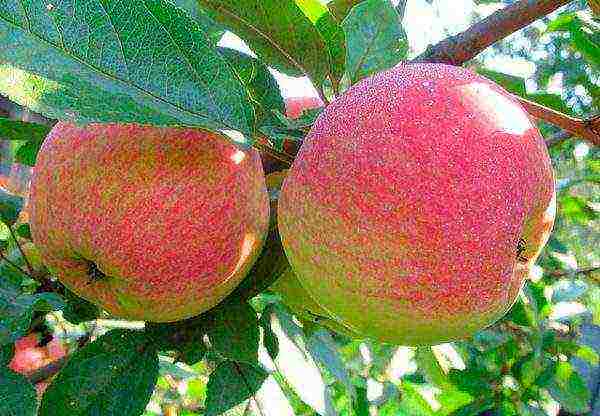
Apple Candy will appeal to kids due to its special sweetness
Mantet
The Mantet variety also deserves attention. The trees are low (no more than 4 m) with a thin crown, do not require frequent pruning. The variety is fast-growing (the first apples appear in the third year) and early-ripening. Begins to bear fruit from the end of July, and the harvest gives gradually over a month or more. Some consider this a disadvantage, however, for those living near the garden, Mantet is a true find, since it provides an opportunity to feast on fresh, ruddy, excellent-tasting fruits for almost half the summer. Apples are stored for about three weeks, suitable for processing, but their juicy, aromatic and fragile pulp is incomparable fresh. There is a subtle, pleasant sourness in the taste.
The yield of the variety is high, winter hardiness is average, but the scab can cause great harm to the apple tree in a rainy year.
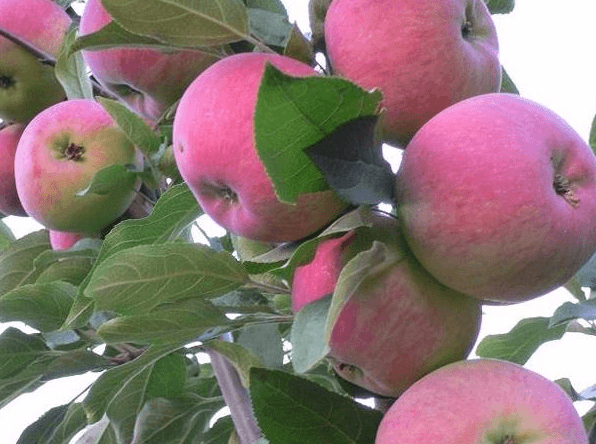
The Mantet variety yields a harvest within a month and a half.
Lungwort
Lungwort is a well-known, high-yielding, fast-growing. It is considered one of the best summer dessert varieties. The taste contains special spicy honey notes. The flesh is yellowish, the skin color is yellowish-green, a red blush with brown stripes appears in the sun. Fruit weight up to 120 g. Ripens at the beginning of August, for a summer variety it is perfectly preserved (until October). Low acidity makes Medunitsa a dietary variety.
But the main advantages that will delight any gardener:
- the root system is not afraid of nearby groundwater;
- high winter hardiness;
- resistance to scab and fruit rot;
- at an unfavorable time for pollination, it still gives a stable harvest.
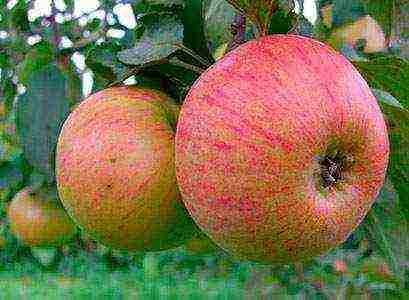
The fruits of the apple variety Medunitsa are tasty and healthy, and she herself is unpretentious in growing
For the sake of so many merits, it is worth getting to know her better. If you want apples that the whole family will love, then this is the Lager. It is both tasty and healthy.
Melba
The Melba variety has been a favorite of amateur gardeners for many years. Especially appreciated for the fact that the apple harvested at the stage of incomplete maturity is transported and stored better than other summer varieties. A very productive apple tree, it can yield up to 150 kg per tree, and the trees themselves are not very large. The weight of one fruit reaches 120-180 g.
The apple pulp is white, with pink veins, of a delicate consistency, has a candy aroma characteristic of the variety and a pleasant taste, assessed by tasters as "excellent".
Of the shortcomings, low scab resistance is noted.
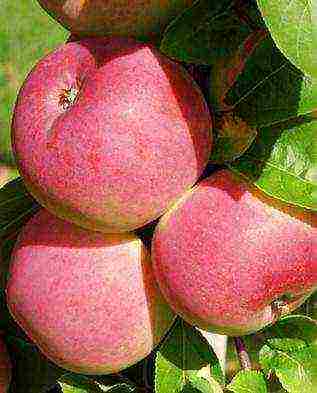
Melba will delight you with early ripening and excellent taste, but requires protection from scab
Williams Pride
Speaking of promising new varieties, how not to mention the amazing Williams Pride? Its fruits can be stored for up to 50 days, but they are not wonderful for that. Apples have an unusual raspberry-purple color and a rather large mass - up to 200 g. The light creamy pulp has a delicate aroma and pleasant taste, grainy, firm and crunchy. The tree, as a modern gardener needs, is not tall, does not tend to form a dense crown, is fast-growing and fruitful. An adult plant produces up to 60 kg of fruits.
And with all this, Williams Pride is resistant to scab and powdery mildew, winter-hardy and simply beautiful. He has every chance to take a worthy place in the gardens of Ukraine.
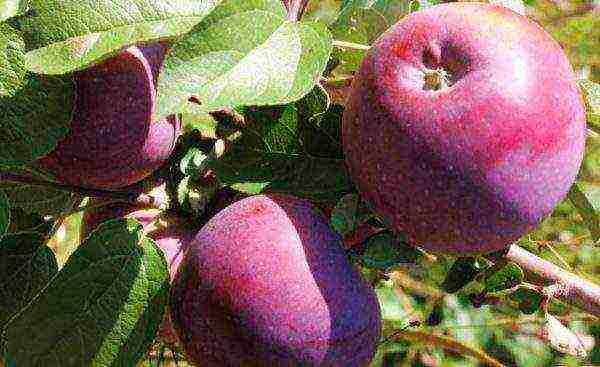
Purple apples are not a mistake of nature, but a wonderful variety Williams Pride
Close
Finally, let us recall the remarkable discovery of breeders - the Close variety, which ripens two weeks earlier than other summer ones, before the White filling itself. Already at the end of June, you can enjoy its tasty and juicy fruits (and they are delicious and juicy for all the apple trees presented in the article, but Close also has super early ones). And, importantly, this variety has all the advantages we have noted: medium-sized, not prone to crown growth, winter-hardy and resistant to major diseases. Breeders have tried their best!
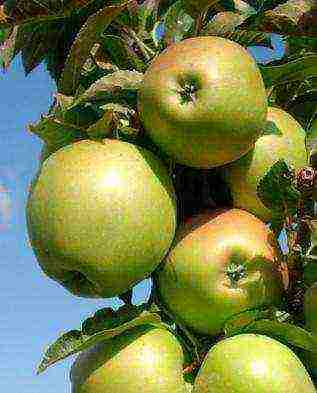
Close is an early variety that surpassed even White Naliv in early maturity.
Autumn varieties, eye charm
The main value of autumn apples is their high content of vitamins and sugars. They make the most beautiful blanks for the winter, and they, in fact, are bred for this.
- Teremok is a winter-hardy variety of Ukrainian selection. Has immunity against powdery mildew and scab. It is early (in the third year), yields stable, 40-50 kg of apples are removed from an adult tree. Fruits are leveled, light yellow with orange-red strokes, weighing up to 200 g. The pulp is juicy, tender, sour taste. The variety ripens in early September, the fruits are used fresh and for the preparation of juices, compotes, and preserves. It tolerates transportation well;
- Gala. The variety was bred in New Zealand, but fell in love with the whole world for its excellent taste and unpretentiousness during cultivation. It is famous for its good yields, tasty fruits and resistance to frost and disease. Not very large, spreading trees can yield up to a centner of quality apples. The fruits are very beautiful, the flesh is yellowish, crumbly, it tastes like a pear. Ripening begins at the end of September and lasts until the November frost. The preservation of fruits is 3-4 months. Requires thinning of flowers and ovary;
- The delicacy has a number of advantages. It is a winter-hardy variety, not prone to periodicity of fruiting, high-yielding and fast-growing. The integumentary color of the fruit is yellow, there is a bright striped blush, the flesh is tender, white, of excellent taste. Apples are stored for 3 months in the refrigerator.Fruiting from late September to mid-October. The tree is of medium vigor and thickening, prone to overloading with fruits, therefore, summer pruning and thinning of the ovaries are necessary. The variety is resistant to powdery mildew, scab and fire blight;
- Delicia is a variety of American selection. The tree is medium-sized, compact. It tolerates winter cold well, in addition, it has resistance to a number of diseases: scab, powdery mildew and brown spot. A fast-growing, stably fruiting variety, yield at 10 years of age up to 55 kg per tree. Apples reach a mass of 180-190 g, greenish-yellow with a red blurry-striped blush and almost imperceptible subcutaneous dots. The pulp is pinkish-white, fine-grained, of medium density, excellent sweet and sour taste. Apples ripen at the end of August and can be stored for almost three months. The transportation is well tolerated. It is used both fresh and canned. The cultivar needs thinning pruning in the early years of growth. The best pollinators are Antonovka ordinary, Glory to the Winners;
- Mlievchanka. A new variety of Ukrainian selection. The tree is vigorous, up to 5 m in height, with a compact columnar crown. Begins to bear fruit in the third year after planting, gives high yields without a tendency to decline over time. The fruits are large (150–195 g), light green, with a beautiful raspberry blush. The pulp is light, tender, juicy, excellent sweet and sour taste. It ripens at the end of September. The fruits are stored until January, sometimes longer;
- Liberty is an American variety, high-yielding (up to 120 kg per tree), transportable, scab resistant and relatively powdery mildew resistant. It is interesting for its fruits of the original greenish-burgundy color. Fruits are small, 130–140 g, covered with a bluish-waxy bloom. The pulp is light, creamy, not very dense, rich in juice, sweet and sour. The fruits are stored for up to five months. Ripen at the end of September - October. Florina and Idared are suitable pollinators.
Also worthy of attention are Orion, Logo, Vlasta, whose characteristics are similar to the varieties described.
Photo gallery: autumn apple varieties of Ukraine
The wealth of winter varieties of Ukraine
The variety of winter apple varieties common in Ukraine is impressive:
- Idared;
- Askold;
- Amulet;
- Breburn;
- Granddaughter;
- Goldcream;
- Golden Delicious;
- Gorodischenskoe;
- Darinka;
- Kalvil Donetskiy;
- Katerina;
- Moon;
- Lyubava;
- Minkar;
- Mavka;
- Perlyna of Kiev;
- Fiery;
- Joy;
- Red Topaz;
- Red Delicious;
- Renora;
- Richard;
- Scroll;
- Sirius;
- Scythian gold;
- Solaris;
- Florin;
- Fuji;
- Jubilee Mies.
The peculiarity of winter varieties of apples is that they do not reach their best taste immediately after picking, but after lying down for a month and a half.
Let's consider the main of the above varieties.
Richard
Richard is a German variety that is ubiquitously bred in Germany, but not particularly welcome in Ukraine yet. Perhaps because this apple tree requires heavy, moist soil and humid air to grow, and the climate even in Polesie has changed in recent years towards warming and an increase in the number of dry, hot days in summer. Nevertheless, this variety has many advantages, and it deserves to be mentioned.
Richard is a prize-winner in many nominations. He has the largest (300 g and even more) fruits... An intense pink blush covers almost the entire apple. The yellowish pulp is dense, very sweet, of a pleasant consistency, rich in vitamins and fiber.
Richard's apples are useful for diseases of the kidneys, heart, obesity.
The plant's resistance to diseases is noted, it does not require protection measures, the only thing that needs to be paid attention to when growing is irrigation. And the fruits are stored until April-May. Gardeners of Polesie (where heavy clay soils and loams are found), who have the opportunity to conduct frequent watering, should pay attention to this variety.
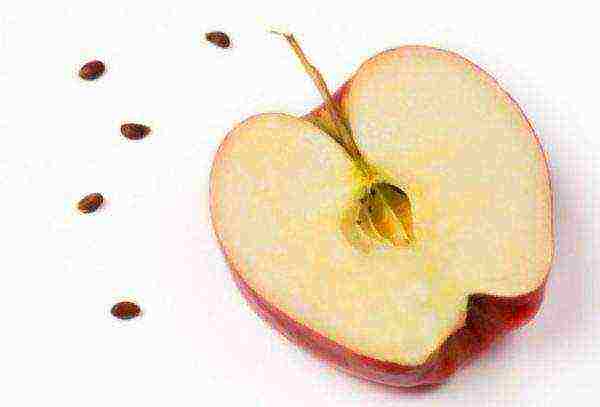
The taste, yield and longevity of Richard's apples are beyond praise
Idared
Idared is a thermophilic variety of American selection, ideal for cultivation in the southern regions. It is appreciated for large (200 g and more), tasty, very beautiful, yellow apples with a raspberry-red "tan", rich in nutrients. The sugar content in them is low, but there are antioxidants that prevent the development of many diseases.
Of the positive properties of the variety, the ability to grow and bear fruit well on poor soils is also noted.
Pollinators are required, such as Florina or Gloucester. Apples ripen at the end of September, and they are located on the branches in bunches, which looks very impressive and greatly facilitates the collection of fruits. Stored for up to six months. It is no exaggeration to say that this is one of the most famous varieties in Ukraine.
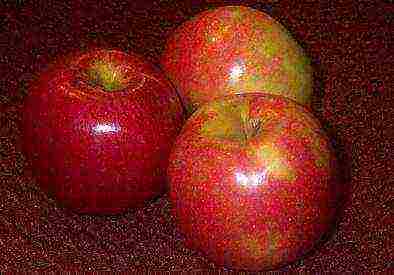
"There are no apples more popular than Idared in Ukraine!"
Amulet
Amulet is a variety suitable for growing in any region of Ukraine. It seems to be specially bred for amateur gardeners: it does not require special care, has immunity to all common diseases, and the taste of the juicy creamy pulp is rated at five points. The fruits are large and very large, some gardeners claim that they removed the half-kilogram apples of the Amulet! True or not, the strain is clearly worth considering. Fruits are harvested in September, they can be stored for five to six months. Of the pollinators, Gloucester and Freedom are suitable.
Particular attention should be paid to controlling the growth force of the branches.
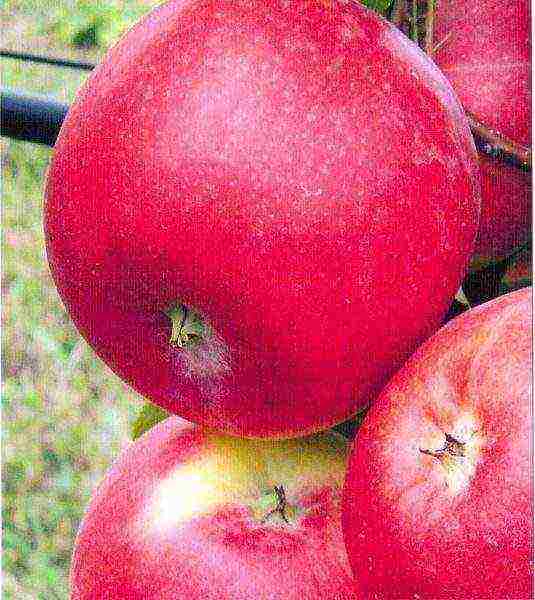
Amulet variety is suitable for growing in all regions of Ukraine
Florina
The Florina variety came to Ukrainian gardens from France and was immediately greeted warmly. The parents of the variety include the famous Golden Delicious and Jonathan, and he took the best from them.
The aromatic and sweet apples are slightly melon-like in taste, especially at the end of the shelf life, and it can last until March under normal conditions, in the refrigerator, and until June.
Of the advantages of the variety, it should be noted that it is undemanding to growing conditions and resistance to scab. This apple tree can tolerate shading, drought, feels great in hot summer, is not afraid of winds and drafts. Fruit picking begins in mid-October. It is also worth remembering the short stature (up to 3.5 m) and the regular yield of the variety. Requires pollinators (Golden Delicious, Ruby Dookie, Jonathan). Fruit weight 150 g.
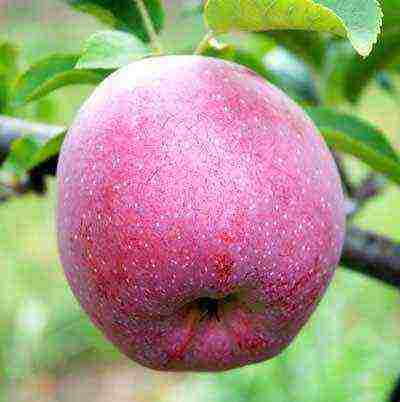
Frenchwoman Florina has firmly won the love and respect of our gardeners
Lyubava
The Lyubava variety has been considered elite in Ukraine since 1992. The tree is capable of producing yields in the second or third year after planting and rapidly increasing yields in subsequent years. A variety of high winter hardiness, immune to scab and powdery mildew. Apples weigh up to 250-270 g, they are rich in nutrients and very tasty.
The ability of the variety to recover from damage is noted, as well as undemanding care.
The fruits begin to be harvested in mid or late September, and their keeping quality allows you to treat Lyubava until March. Apples are good, both fresh and in the form of compotes, jams, juices.
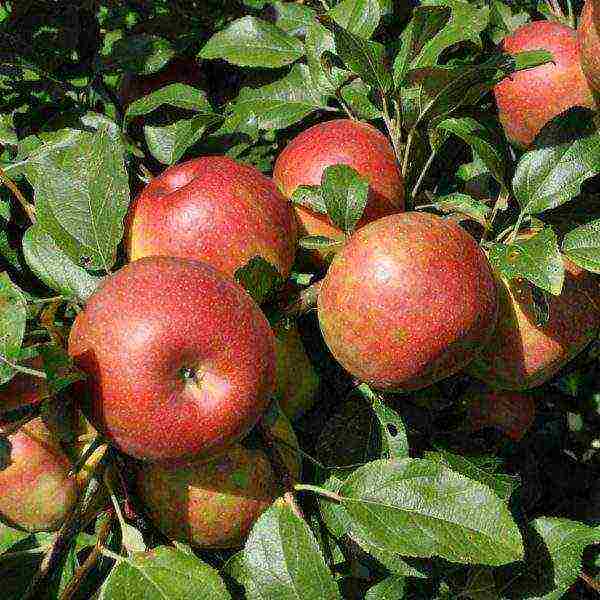
Apple-tree Lyubava is an elite high-yielding variety
moon
Recently, the Czech variety Luna has been gaining popularity. Among the advantages of the variety, high resistance to diseases, large-fruited (up to 250 g), the ability of the fruits to be stored until the end of spring are declared. The variety is included in the State Register of Recommended Varieties for Use, so it is worth paying attention to those who like to be a pioneer and experiment on their site.
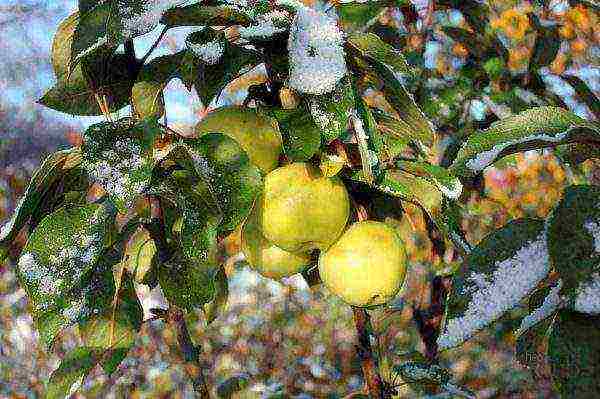
This yellow beauty Luna deserves to be a decoration for your garden.
Granddaughter
Variety Vnuchka has every chance of becoming a favorite in Ukrainian gardens, since it is resistant to scab and powdery mildew, winter-hardy, gives large fruits with excellent taste, which persist until May next year with almost no loss.
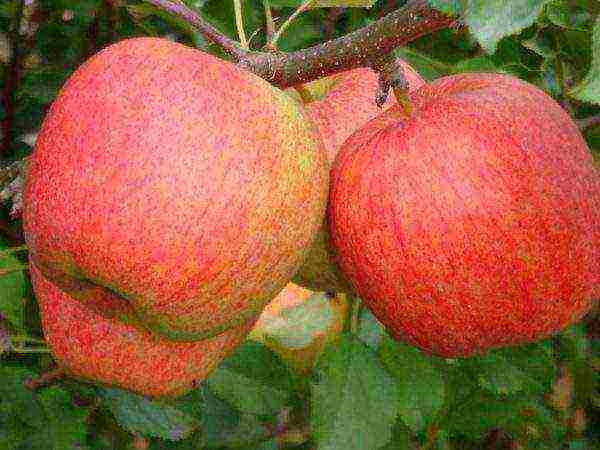
The variety of Ukrainian selection Granddaughter will soon become popular outside the country, since its characteristics are excellent
Fuji
Fuji is an exotic apple tree that could very well be a hit in gardens and home gardens. This is a Japanese variety, famous abroad, but not yet very well known in Ukraine. Reviews about him unanimously state: excellent in taste, easy to grow. As for the other characteristics, they are also pleasing - the fruits can reach a mass of 250 g, and are stored in the refrigerator until May. With regular thinning of the ovary, the tree tends to bear fruit generously every year. Fuji tolerates pruning well, and crown formation is painless. Large, wonderful-looking fruits have a crunchy, melting pulp, which is pleasing to the eye with its delicate creamy shade.
In addition to appearance, Fuji fruits are also distinguished by useful properties. They are recommended for diabetes, metabolic disorders, risk of cardiovascular diseases.
A feature of the fruits is not the highest taste for the first or second year, but you should not be upset ahead of time, then they will reveal all their wonderful properties. Apples are usually eaten raw, but they also make excellent confectionery. They are also good baked.

You don't need to fly to Japan to get to know Fuji - take a look at the garden
To make the apple tree fertile: features of care in different regions of Ukraine
Having responsibly chosen varieties of apple trees, one should take the choice and planting of seedlings no less seriously. After all, you are laying a garden not for a year or two, but for decades.
Selection of seedlings
Before you buy apple trees, make sure there is enough room for them in your garden. Medium-sized varieties require planting at a distance of 5 m from each other. dwarf ones allow planting at intervals of 3–3.5 m. The level of groundwater is also important. If they come no closer than 2 m to the surface, medium-sized varieties will feel comfortable. For dwarf apple trees, the presence of groundwater at a depth of 1.5 m is permissible.
The main rule: do not make random purchases. You can get it from the hands of well-known local breeders who have been supplying seed varietal material to the market for several years. Otherwise, you should contact specialized stores and breeding nurseries.
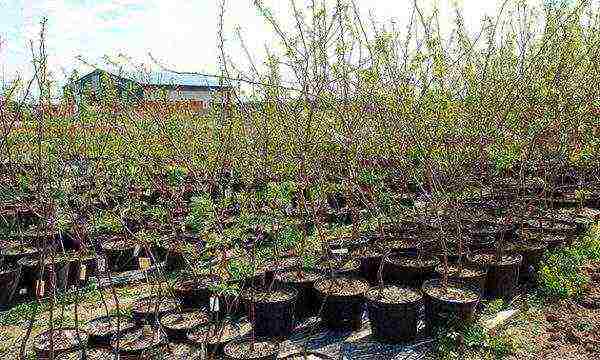
Buy seedlings without leaves, as a last resort with barely blossoming buds
A specialized store is preferable for the reason that you can immediately get advice from the seller on plant care, as well as purchase a set of products to combat pests and diseases common in your region.
As for the seedling itself, a number of very significant requirements are imposed on its quality:
- roots. The main thing for the life and nutrition of any plant. Pay attention to the condition of the roots of the potential acquisition. The best option is when the root system is closed, the part visible from above is well moistened and has no protruding dry parts. If the roots are open, you should pay attention to their condition. They should not be bare (such a tree, unfortunately, is unlikely to take root) or overdried. It is good if the size of the roots reaches 30 cm. It should be checked if there are any growths, thickenings on them;
- trunk. Smooth, smooth, without wounds, damages, build-ups and sagging. Under the bark, a healthy stem will be a bright green "young" color. Check if the vaccine has taken hold. To do this, you need to take the plant and slightly pull the stem. The rotted grafted part will separate from the trunk;
- branches. Indicates the age of the seedling. A one-year-old may not have them, a two-year-old may not have two or three. Moreover, they should not stick out at right angles to the trunk, since this is evidence of an incorrect vaccination, or they are trying to unobtrusively sell you a wild apple tree;
- leaves. They should not be on the seedling at all. If possible, you should take a plant with unblown buds.
Video: how to choose an apple tree seedling
Planting an apple tree
So, you bought the seedlings. Transport them to the planting site carefully, ensuring that the roots are moist enough. Tie the branches to the trunk.If it is not possible to immediately plant a plant with an open root system in the ground, dip it in a mash made of clay and mullein.
Apple trees are planted in spring and autumn. Autumn planting is preferable because it provides better plant survival.
Pits for trees are prepared ahead of time, in a week or two, with a diameter of 80 cm and a depth of about 60–80 cm, depending on the variety, on poor soils a little deeper. Fertile chestnut and chernozem soils of the steppe and forest-steppe do not require initial fertilization. In the north of Ukraine, where the soil is poorer, a nutrient mixture is introduced into the planting pit: 2 buckets of humus, 2 buckets of fertile soil, 20 g of nitrogen, potash and phosphorus fertilizers. The mixture is placed on a mound, on which the roots of the tree are carefully spread (provided that the root system is open).
If the soil is too light, contains a lot of sand, then a layer of ameliorant (clay, peat) up to 10 cm thick is added to the bottom to retain moisture. On clay soils, on the contrary, it is advisable to add sand to the holes.
As it is poured, the earth is tamped, the seedling is shaken slightly to avoid voids inside the pit. The root collar of the seedling should be 3-5 cm above the ground level, in no case should it be allowed to sink into the soil. Planting is completed with watering - two or three buckets of water under each tree. The seedling is tied to a peg to protect it from the winds. The soil in the hole can be covered with mulch.
Video: planting seedlings
Top dressing and watering apple trees
Top dressing of apple trees consists in the introduction of organic, potash and phosphorus fertilizers during the autumn digging. Nitrogen fertilizers are applied in spring or early summer twice, one and a half matchboxes of ammonium nitrate and a box of urea in the near-trunk circle, evenly distributing around the tree.
Soil moisture is provided by irrigation from mid-May to early August in the forest-steppe and Polesie. In the steppe zone, special attention should be paid to irrigation, avoiding overdrying of the soil. They start watering there earlier and finish in early September (for winter varieties). In general, watering should be stopped two weeks before harvesting to avoid cracking.
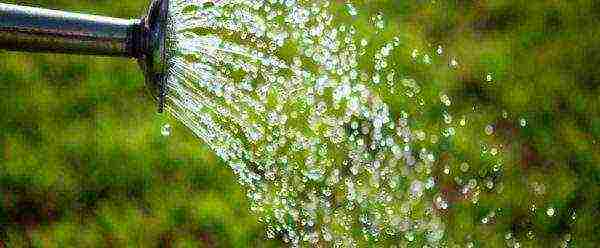
Water your apple trees generously and they will thank you for caring for the harvest.
Apple trees are watered every three weeks, spending two to three buckets per plant. More is possible in dry summers. Be sure to loosen the soil of the trunk circle after watering. The so-called podzimny water-charging irrigation will not be superfluous. It is carried out when all the leaves have fallen from the trees. This creates a moisture reserve for the next season.
Pruning trees
Forming the crown of an apple tree is a responsible business. Fruit trees are pruned so as not to slow down their growth and not reduce yields over the years.
Experts advise to form the crown in a sparse-tiered type, in two tiers, with a distance of 70 cm between them, and leave the bole about 40-50 cm. The distance between the branches in the tier is up to 30 cm.
In low-growing apple trees, the crown is formed fusiform. Since they do not have strong skeletal branches, they leave semi-skeletal ones.
If there is a weak growth of shoots, then you can carry out anti-aging pruning by removing part of the branch above the near side branch.
Plant protection from pests and diseases
Unfortunately, sometimes it is impossible to do without plant protection chemicals. They should be used strictly according to the instructions; in small areas, replacement with folk remedies is quite acceptable.
Chemical protection is carried out according to the following scheme:
- in the leaf phase "bear ears" to protect against the apple blossom beetle, kidney weevils, the wintering stage of pathogens such as scab, powdery mildew and fruit rot, mixtures of Aktara + Horus preparations are used;
- the next spraying is carried out with a mixture of Enzhio + Horus preparations in the phases of bud and rose bud extension. This treatment protects trees from the apple blossom beetle, leafworms, aphids, suckers and a complex of pathogens: scab, powdery mildew, Alternaria, fruit rot.In the steppe zone in Ukraine, Tiovit Jet is added to combat fruit mites;
- in the phases of falling of petals and after flowering, for the simultaneous fight against apple sawfly, leafworm, apple moth, larvae-"vagrants" of the Californian scale insect, aphids, honeydew, moths, with diseases (scab, powdery mildew, alternaria + or mixtures of Aktara preparations) Match or Brand and add Speed. During long periods of rain and when there is abundant dew, Horus is added;
- the approximate period of the fight against the first generation of the codling moth is the beginning of flowering of white acacia or after the end of flowering of late varieties of apple trees. Spraying against caterpillars of the next generations of the codling moth falls on the 30–35th day after the previous one. Varieties that are sensitive to powdery mildew are sprayed with a mixture of Aktara + Proclaym and Topaz, and if there is a threat of scab development, Horus is added.
Of the features inherent in Ukrainian gardens, it should be noted the presence of such a dangerous ground pest as the May beetle. Therefore, from mid-April, it is worth treating the tree crowns with Aktar, Prestige or Antikhrushch means, as well as shedding the soil of the near-stem holes with these means, following the instructions.
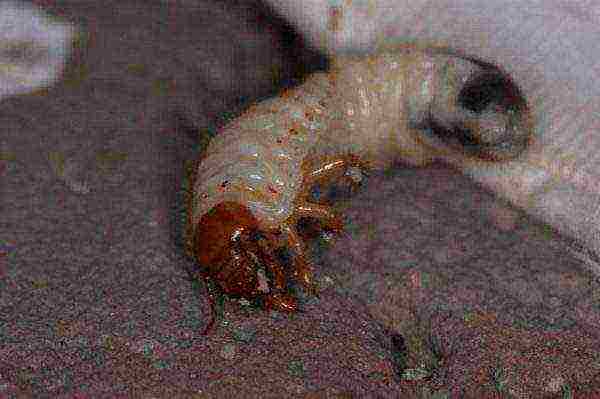
This small beetle larva is capable of destroying an entire apple tree
Video: the fight against diseases of apple trees (in Ukrainian)
Reviews of gardeners about varieties of apple trees common in Ukraine
Review of the Amulet variety
Florina variety review
The apple tree was and remains the favorite of Ukrainian gardeners. In addition to old varieties, attention is attracted by new, early-growing and small-growing ones, with increased resistance to diseases. Modern varieties of apple trees are the best suited for growing in amateur gardens. They are undemanding to care for and give stable yields. By choosing several new varieties of apple trees of different ripening periods, you will provide yourself with fresh apples and various harvests from them for the whole year.
Rate the article:
(2 votes, average: 5 out of 5)
The apple tree has long been considered the most popular fruit tree that grows in every garden. Time passes, everything changes, and the breeders are not sitting idle: they bring out new varieties of apples that win the hearts of lovers of this fruit. Nowadays it is rare to find varieties Aport, Korobovka, Borovinka - they have long lost their positions, but the newest varieties are gaining momentum. We will describe the most interesting varieties of apple trees in our article, and also consider where you can buy the best apple tree seedlings in Ukraine.
Summer varieties of apple trees
White filling. Baltic culture, which bears its first fruits in early summer. Very fruitful and perfectly preserved in winter. The apples are medium in size, juicy and sweet and sour in taste. This variety responds well to pruning, and it is even useful to do this systematically in order to avoid impaired fruiting.
Mantet. The fruits of this tree are medium in size, and sometimes small, but this species is popular for its very thin peel. Mostly they have a bright red color with an orange tint. Ripen in late July or August, depending on weather conditions. However, they deteriorate very quickly, the consumption period is only 10-15 days after removal from the tree. The disadvantage of this summer variety of apple trees is that the yield of the tree is high only at a young age.
Melba. It has large fruits with a striped ruddy color, covered with a waxy bloom. The apples of this culture are distinguished by an incredible candy flavor and snow-white pulp, very juicy and great for juices and compotes. Summer species of apple trees do not tolerate transportation well, but this class can be stored until December.
Folding. An early apple tree with loose flesh, but at the same time quite juicy, acid in excess.The disadvantage is the frequency of fruiting and a short period of consumption.
Autumn varieties of apple trees
Gala. This crop became available to Ukraine in the 70s, when breeders were alarmed that small fruits would not be accepted in the markets. However, buyers were attracted by the bright color of the apples. An adult apple tree produces approximately 55–80 kg of fruits, which are used mostly in the production of juices.
Delicacy. The class was bred in America, but quickly enough interested the Ukrainian consumer, since it is especially frost-resistant, not susceptible to pest attack and has stable fruiting. It is used for fresh food, as well as for the production of juices.
Liberty. Refers to early autumn varieties. There are practically no disadvantages of this apple tree, its fruits are used less often fresh, and they are best suited for jam, jams and dried fruits.
Glory to the winners. It used to be a huge success, but now, due to the rise in temperature, it is considered a finicky variety. It requires a lot of attention and increased care. At the same time, the tree will thank the fruits of the highest quality.
Winter varieties of apple trees
Fuji. The variety was bred in Italy, but takes root well throughout Ukraine. The winter variety is distinguished by its gorgeous taste: the fruit is honey-tasting, juicy and aromatic. Stored until next year's harvest.
Increased winter hardiness allows growing this type of apples in industrial gardens of the Kharkov region.
Idared. Bred by breeders of America, but apple trees of this category are easily used in Ukraine on the territory of industrial gardens. The fruits grow to a large size, covered with a thin waxy layer. Suitable for any kind of activity: it is used fresh and in all types of processing.
Golden Delicious. Among winter varieties, it is considered the most dessert, most often consumed fresh. The trees are quite frost-resistant, but highly susceptible to insect attack.
Gloucester. Breeders of Germany worked on this species. For scientific purposes and in small volumes for production, the variety is grown in the Sumy region of Ukraine, where seedlings can also be purchased. The fruits are medium in size and are eaten only fresh. They are stored for a very long time and are well transported.
Spartan. The species has unusual characteristics as for winter apples. Firstly, the color of the fruit is unique - rich burgundy, plum, while covered with a thick layer of wax bloom. Secondly, the fruits are huge, slightly flattened at the base. Used to make jam.
Champion. One of the most common types of trees. Apples are eaten fresh. The category does not stand out in anything special, but it is popular due to its ease of care.
Columnar apple varieties
Trident. Weak tree of dwarf culture. Formed from many short branches extending at right angles from the trunk. It blooms very intensively, but at the same time the average rate of fruit set. This variety is grown in the Kiev region.
Gin. A low-growing tree, reaches a maximum of two meters in height, the trunk is even and is covered with red fruits. Begins to bear fruit a year after planting. In the first 4 years, the yield is low - up to 5 kg, and after that it is 12-15 kg per year. The variety is very resistant to disease.
The president. The description is similar to the Gin variety, but the color of the fruit acquires a green tint. It is considered a winter variety with high pest adaptation.
Video "Review of the best apple varieties"
In this video, you will hear about the best apple varieties.
VARIETY
DESCRIPTION
PHOTO
QUINTY
The tree is highly winter-resistant, resistant to powdery mildew. Fast-growing. Fruits are medium-sized (120-150 g), one-dimensional, rounded-conical with a ribbed top, greenish-yellow, with an intense striped red-burgundy blush over the entire surface of the fruit. The pulp is light creamy, dense, very juicy, harmonious sweet and sour taste (4.3-4.6 points), with a weak aroma.Ripens at the end of July.
MELBA
Summer variety. The fruit is medium-sized - 100 -120 g, round in shape. The main color is greenish-yellow, in mature fruits it is white or yellowish-white with an intense red, striped blush. The pulp is very tender and juicy, sweet and sour taste, aromatic.
Papirovka
A variety of early summer ripening period.
Medium sized trees. The variety is winter-hardy, scab resistant. The yield is average, the early maturity is high. Fruits are below average and average size (80-100 g), round-conical in shape, with a longitudinal, narrow seam. The main color is greenish-yellow. The pulp is white, tender, juicy, loose. The taste is good, sour-sweet.
ANTONOVKA
An old Russian winter apple-tree variety. Fruits are large (125-150 g), yellow, sometimes with a blush, wine-sour taste, with an aroma inherent only in this variety. It stands out among other varieties for its winter hardiness, undemanding soil.
DIVISION
Autumn grade. The fruits are large - 150 -190g, the main color is golden-yellow with a solid or blurry-striped blush. The pulp is dense, juicy, sour - sweet taste. The winter hardiness of the variety is high.
PRIMA
A variety of early autumn ripening period. DOESN'T AFFECT SANDY, fast-growing, winter-hardy, high-yielding, transportable. Fruits are dark red, juicy, aromatic, delicate, harmonious sweet and sour taste.
GLORY TO THE WINNERS
Ripening period - early autumn. The beginning of fruiting - 3-4 years. Fruit weighing 125 - 185 g, round-conical shape. The color is greenish-yellow with a bright red blush. Creamy pulp with pink veins, delicate, juicy, sweet and sour with aroma.
TEREMOK
Ripening period - autumn. The beginning of fruiting is 3 years. Fruits weighing from 140 to 220 g are of average one-dimensionality. The skin is of medium thickness, firm, elastic, dry, smooth. The pulp is light yellow, fine-grained, juicy, aromatic, sweet and sour. Tasting score 4.2 - 4.5 points
IDARED
A variety of American selection. Fruits 130-140 g, yellowish skin with a bright dark red blush, with a purple tint and a waxy coating. The pulp is creamy white, dense, juicy, slightly sour, aromatic, of excellent taste, annual fruiting and abundant, stored until May-June.
FLORINA
Winter grade. The beginning of fruiting is 3 years. Fruit weighing 110 - 145 g, cut in a cylindrical shape with wide ribs. The color is light yellow with a bright red blurry-striped blush on almost the entire fruit with a bluish bloom. The pulp is yellow, medium firm, juicy, sweet. Tasting score 4.3 points.
LIBERTY
Winter variety from the USA. Medium-sized fruits - 110 -150 g, round. The skin is thin. The color is yellowish-green, integumentary dark cherry. The pulp is dense, tender, juicy, sour-sweet taste (4-4.2 points).
Rosavka
Late winter grade. Fruits weighing 160 - 200 g, individual up to 280 g of rounded-cylindrical shape. The color is greenish yellow with a dark red blush. The pulp is greenish-creamy, dense, juicy, sweet and sour, fine-grained. Tasting score 4 points.
ASKOLDA
Ukrainian late winter variety with large, juicy, aromatic fruits of excellent harmonious sweet and sour taste. The variety is characterized by early maturity, regular high yield, winter hardiness.
ANTEY
Late winter grade. Fruits are large (from 130 g), rounded-conical, slightly flattened with wide smoothed ribs. The skin is light yellow with a strong waxy flight. The pulp is greenish, juicy, sweet and sour taste. The fruits ripen two months after harvest and are stored until April-May.
GALA
Winter variety from New Zealand. Fruits are above average (135g), golden yellow with a blurry striped carmine-red blush. Clone Gala Mast, has a more intense coloration. The pulp is light yellow, juicy, fragrant, of excellent sour-sweet taste (4.5 points).
GALA MAST
Winter variety from New Zealand. Winter-hardy variety, resistant to powdery mildew. Average annual yield.Fruits are above average (135g), golden yellow with a blurry striped carmine-red blush, a more brightly colored clone of the Gala cultivar.
GLOSTER
Late winter variety of German selection. Fruits are large (160-200g), round-conical, ribbed, light yellow with a crimson-red blush. The pulp is light creamy, juicy, pleasant sweet and sour taste (4.3-4.5 points).
GOLDEN DELICHES
Ripening period - winter. Fruits weighing 120 - 190 g, elongated-rounded-conical, greenish-yellow, with large light brown combs, sometimes with a slight orange blush. The pulp is yellowish-creamy, dense, juicy, fine-grained, aromatic, with an excellent sour-sweet taste. Tasting score - 4.6 points.
GOLDEN RESISTANT
Winter variety of American selection. The attention of gardeners was attracted by the high taste of the fruit and a higher winter hardiness than that of Golden Delicious. Also, the variety is distinguished by its yield, stable fruiting, high resistance to scab and powdery mildew.
JONATHAN
Late winter grade. Medium-sized fruits - 100 - 130 g, round-conical shape. The main color is golden yellow, the integumentary color is dark red, a blurred blush on most of the surface, often with rustiness. The pulp is dense, juicy, sour - sweet, with a pronounced aroma, high taste.
Jonagold
Late winter variety of American selection. Fruits are large (140 g), round, greenish-yellow with an orange-red blush. The pulp is yellow, juicy, with a very harmonious sweet and sour taste (4.6 points).
EDERA
Late winter variety of Ukrainian selection. Fruits are large (170-220g), broadly conical, greenish, for the most part bright, purple blush. The pulp is creamy, juicy, sweet and sour harmonious taste (4.25-4.5 points).
ELSTAR
Winter variety from Holland. The fruits are large (150-180g), elongated-cylindrical, yellow, with a red-orange striped blush on most of the surface. The pulp is light yellow, juicy.
KATERINA
Late winter grade. Ultra-fast-growing. Fruits are large - 160 - 190 g, truncated - conical, greenish - yellow with a blurry striped blush. The pulp is dense, juicy, with a good sour-sweet taste.
COLUMN-SHAPED
The columnar shape of the apple tree crown is a type of crown in which the branches of the tree grow exclusively vertically upward, and there is practically no lateral branching on them. This is a natural form of the apple tree, and such a crown is formed in the form of a column without human intervention.
RENETH SIMIRENKO
Late winter grade. Fruits are large - 150 - 200 g, round - conical. The skin is green, smooth on the sunny side with a reddish - brown blush, large, light, subcutaneous punctures. The pulp is dense, white, with a greenish tint, juicy, aromatic, with a harmonious content of acids and sugar, dessert taste.
PRIAM
Autumn apple variety. The color is red. The calendar dates of ripening are 3 ten days of August. Fruit weight 120 grams. Tasting score 4.3 points. High winter hardiness. Scab resistant.
SAFFRAN KRASNOKUTSKY
Late winter variety of Ukrainian selection. The fruits are large (150-200 g), broadly conical, yellowish-green with an orange-violet blush for 3/4 of the fruit. The pulp is white, juicy, harmonious sweet and sour taste (4.3-4.5 points).
SIMIRENKOVETS
Winter grade. The tree is vigorous, with a rounded or flat-round crown. The fruits are large - 180 - 240 g, flat-round, or round-conical. The skin is smooth, shiny, light green. The pulp is white, dense with a greenish tinge of good sweet and sour taste.
SPARTAN
Winter grade. The tree is medium-sized, with a highly rounded crown of medium thickening. Fruits are medium-sized, flat-round. The skin is thick, dense in a continuous, easily washable purple bloom. The pulp is dense, white, juicy, with an excellent sweet and sour taste.
CHAMPION
Winter variety from the Czech Republic. Oen is a fast-growing and fruitful variety, bears fruit stably.Fruits are above average in size, round-oval, greenish-yellow with a light red blurred blush on most of the fruit. The pulp is greenish-creamy, juicy, with a very pleasant sweet taste.
RAIKA
The Czechoslovakian variety was bred in 1983 by crossing the Champion with Katkoy. Fruits are medium-sized (120-150 g), one-dimensional, flat-round, light yellow with a red blush on most of the fruit surface. The pulp is yellow, juicy, fragrant with a pleasant sweet and sour taste. It tastes like Champion.
SR 05-23
Hybrid of the autumn ripening period. Medium pods are 110 -145 g, almost the entire surface is red. The pulp is juicy, good sweet and sour taste. The fruits are harvested in early September, stored until December - January.
KATIA
The tree is of medium growth vigor, hardy. Fruits are medium (118 m), high commercial quality, summer ripening period. The peel is yellow-green with a blurred red blush that covers almost the entire surface of the fruit. The pulp is creamy, very dense, juicy, grainy, with a good sweet and sour taste.
